March 2023 hayandforage.com
Horse owners have their say on hay pg 10
Time for interseeding pg 12
Self-fed ensiled forage reduces labor costs pg 14
Cocktail forage mixes: What do dairy cows think? pg 20

Published by W.D. Hoard & Sons Co.
SAVE ON QUALITY HAY AND


















3.9% FOR 36 MONTHS OR 5% CASH




















ON KRONE DISC MOWERS, TEDDERS, ROTARY RAKES, AND ROUND BALERS
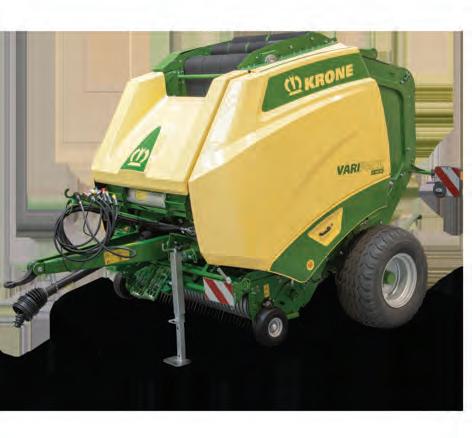
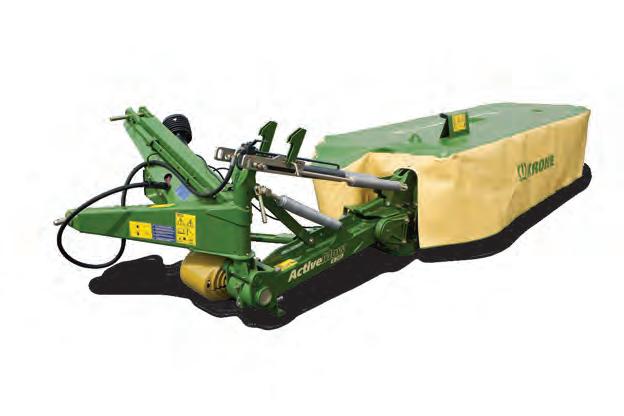
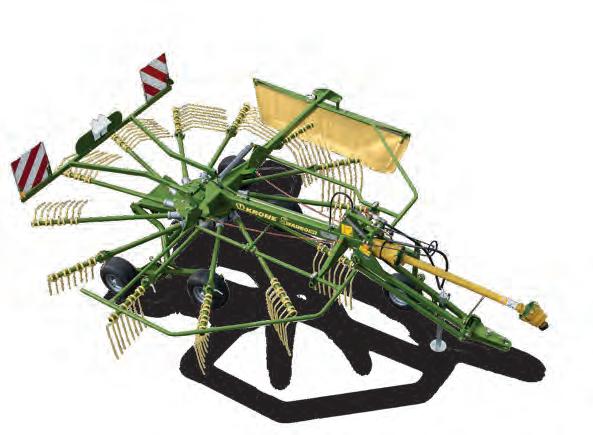
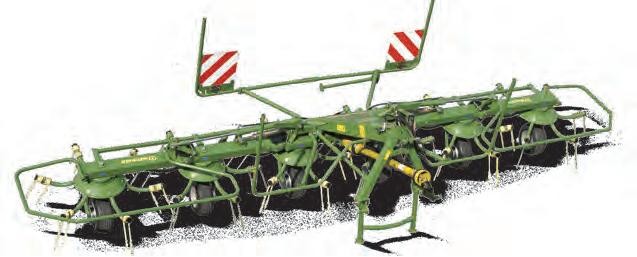






























































EQUIPMENT!
FORAGE
Find your Krone Dealer
DISCOUNT!
He started with busted bales and five cows
Not growing up on a farm, Bill Stevens has built a 20,000-acre hay operation in Washington’s Columbia Basin. The business consists of several vertically integrated entities.
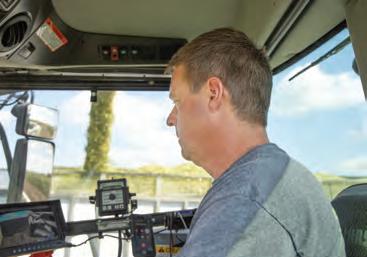
MANAGING EDITOR Michael C. Rankin
ART DIRECTOR Todd Garrett
EDITORIAL COORDINATOR Jennifer L. Yurs
ONLINE MANAGER Patti J. Hurtgen
DIRECTOR OF MARKETING John R. Mansavage
ADVERTISING SALES
Kim E. Zilverberg kzilverberg@hayandforage.com
Jenna Zilverberg jzilverberg@hayandforage.com
ADVERTISING COORDINATOR
Patti J. Kressin pkressin@hayandforage.com
W.D. HOARD & SONS
PRESIDENT Brian V. Knox
EDITORIAL OFFICE
28 Milwaukee Ave. West, Fort Atkinson, WI, 53538
WEBSITE www.hayandforage.com
EMAIL info@hayandforage.com
PHONE 920-563-5551
DEPARTMENTS
4
Specialized in small harvests
Silver Streak Ag Services serves nearly 50 clients in northwestern Illinois. The business chops about 5,000 acres and makes up to 6,000 large square bales each year.

Multispecies grazing helps pastures and

Adding sheep or goats to a cattle grazing operation can help control undesirable weeds and adds a new profit center.
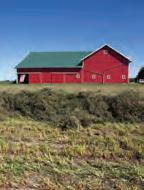
25
A red barn, blue skies, and wilting hay. It was a perfect haymaking day for the field demonstrations held last fall at the National Hay Association’s Annual Convention, where the machinery was humming at John Russell’s farm near Pemberville, Ohio. The patriotic barn belongs to Paul Brueggemeier, a neighbor of the Russells.
HAY & FORAGE GROWER (ISSN 0891-5946) copyright © 2023 W. D. Hoard & Sons Company. All rights reserved. Published six times annually in January, February, March, April/May, August/September and November by W. D. Hoard & Sons Co., 28 Milwaukee Ave., W., Fort Atkinson, Wisconsin 53538 USA. Tel: 920-563-5551. Fax: 920-563-7298. Email: info@hayandforage.com. Website: www.hayandforage.com. Periodicals Postage paid at Fort Atkinson, Wis., and additional mail offices. SUBSCRIPTION RATES: Free and controlled circulation to qualified subscribers. Non-qualified subscribers may subscribe at: USA: 1 year $20 U.S.; Outside USA: Canada & Mexico, 1 year $80 U.S.; All other countries, 1 year $120 U.S. For Subscriber Services contact: Hay & Forage Grower, PO Box 801, Fort Atkinson, WI 53538 USA; call: 920-563-5551, email: info@hayandforage.com or visit: www.hayandforage.com. POSTMASTER: Send address changes to HAY & FORAGE GROWER, 28 Milwaukee Ave., W., Fort Atkinson, Wisconsin 53538 USA. Subscribers who have provided a valid email address may receive the Hay & Forage Grower email newsletter eHay Weekly. March 2023 · VOL. 38 · No. 3
6
22
cows
26
4 WEATHERING THE WEATHER 9 SOIL HEALTH’S BIOLOGICAL BASIS 10 HORSE OWNERS HAVE THEIR SAY ON HAY 12 TIME FOR INTERSEEDING
SELF-FED ENSILED FORAGE REDUCES LABOR COSTS 16 CONTROL HAY HEATING BY WRAPPING LOWER MOISTURE BALES 18 FEWER COWS BUT MORE NET INCOME 19
COCKTAIL
MIXES:
DAIRY
DIGESTION ON THE COVER
Photo by Mike Rankin
14
ARE YOU READY? 20
FORAGE
WHAT DO
COWS THINK? 25 THE NEXT FRONTIER: PROTEIN AND STARCH
First Cut
On
The Pasture Walk
Alfalfa Checkoff
Beef Feedbunk
Forage Gearhead
Dairy Feedbunk
9 Sunrise
Soil 12
16
18
19
20
Feed Analysis
Forage IQ
Hay Market Update
34
34
March 2023 | hayandforage.com | 3
Weathering the weather
FOR those in the business of food production, extreme weather events seem to stick to our brains like a tick on a longhaired dog. We just don’t forget . . . ever.
When I think of drought, the years 1988 and 2012 immediately come to mind. The former was the year I finished graduate school and proceeded to job hunt. The growing season began dry and remained that way for weeks, then months. It was a long, hot, and widespread drought. At one point, 45% of the continental U.S. was categorized as extreme drought, and 11 states declared all of their counties disaster areas. The average U.S. corn yield that year didn’t break 85 bushels per acre. Hayfields and pastures were crispy by mid-summer.
I started my career as an extension agent in mid-August of 1988. The crops looked brutal and were starved for moisture. Then, soon after my first day on the job, it started to rain. From that point forward, I was known as the droughtbreaker in my area. Unfortunately, the damage had been done, and there would soon be the typical drought fallout.


In 2012, I was unable to muster any moisture relief, and my reputation waned.
As we head into the 2023 growing season, many growers in the Great Plains and western Corn Belt are praying the year will provide more rainfall than the past few have. The recent dryness has hit cattle and hay country hard.
Even if you don’t farm or ranch in those parched regions, you’ve still been impacted. Hay stocks are at their lowest level since the early 1950s. The nation’s beef cow herd numbers the fewest head since the early 1960s. Replacement heifers are also in short supply, with many more than usual ending their productive lives in the feedlot because grass was short.
By now, if you haven’t got the message that any grazing plan isn’t complete without a drought component, then you’re not paying attention. Having a plan in place that identifies preemptive triggers for action can mean the difference between suffering a paper cut or an amputation.
Cloudier skies ahead?
Governing our weather patterns from year to year is the surface temperature of a relatively small portion of the ocean. We can attribute the recent drought — and many before — to La Niña, which is the name given to a condition when the ocean surface is cool.
“We’ve been locked into a La Niña weather pattern since 2020, and it has been historically long in duration and strength, but she’s just about done,” asserted Matt Makens during the CattleFax Outlook Seminar at the recent Cattle Industry Convention in New Orleans. Makens is a meteorologist and atmospheric scientist with Makens Weather LLC based in Colorado.
The ocean is warming up, he noted. Moisture conditions have already started to improve this winter in previously drought-stricken areas. “By spring, our models suggest that a La Niña will only be about 14% likely, down from the current 60%,” Makens said.
The reverse situation from La Niña is El Niño, which occurs when the ocean surface warms. Both of these dominant patterns are cause for extreme weather in localized regions around the world. The shift from one to another can take months or seasons for the atmosphere to adjust, and there is often a period of neutrality.
Once La Niña bids adieu sometime in late spring, weather conditions will begin to change. “I expect a more neutral-based forecast as the atmosphere begins to catch up with the ocean conditions,” Makens said. “This means we begin to eliminate the extremes of an El Niño or La Niña. Overall, it should be a more favorable summer for moisture compared to the past several years. Other than the Southwest, temperatures are expected to be neutral to cooler than average in pockets,” he added.
Makens’ weather models suggest that there is only a 52% probability that we’ll have an El Niño weather pattern by next fall. He said that if El Niño does get into high gear, expect a lot more rainfall than what a neutral fall might look like.
“I think this is not likely to happen; it’s too quick of a transition,” the meteorologist stated. “El Niño will kick in, but give it some time.”
The overriding theme to Makens’ weather message was one of mid-term optimism, which is a trait inherent in most farmers and ranchers; it has to be for the sake of mental survival. This doesn’t look like a year that will likely be etched in our weather gray matter, but just in case, have a drought plan. •
Happy foraging,
FIRST CUT
Write Managing Editor Mike Rankin, 28 Milwaukee Ave., P.O. Box 801, Fort Atkinson, WI 53538 call: 920-563-5551 or email: mrankin@hayandforage.com
Mike Rankin Managing Editor
4 | Hay & Forage Grower | March 2023



John Deere Dairy Solutions & Support Your animals. Our solutions. Keeping your herd healthy and productive is your top priority. Helping you do it is ours. From tractors, balers and unrivaled dealer support, John Deere has the solutions and support for every need on a dairy farm. Contact your dealer or learn more at JohnDeere.com/Dairy.
HE STARTED WITH BUSTED BALES AND FIVE COWS
by Mike Rankin
SOAP Lake borders Highway 17 to the east and a town by the same name to its south. Basalt cliffs define the lake with water that is said to contain 23 different minerals. Going back to when Native American tribes inhabited this area of Washington’s Columbia Basin, people have come to soak in the healing waters and lather themselves in the lake’s mud to cure what ails them.
About seven miles northeast of Soap Lake on Highway 28, the focus shifts from high-quality water to high-quality hay, which is made possible by the nonhealing irrigation waters of the Columbia River. It’s here that Bill Stevens manages a bevy of businesses that are vertically integrated to make Stevens Hay Farms Inc. successful. The 20,000acre operation and related entities are supported by family members, about 60 fulltime employees, and 20 to 25 seasonal workers.
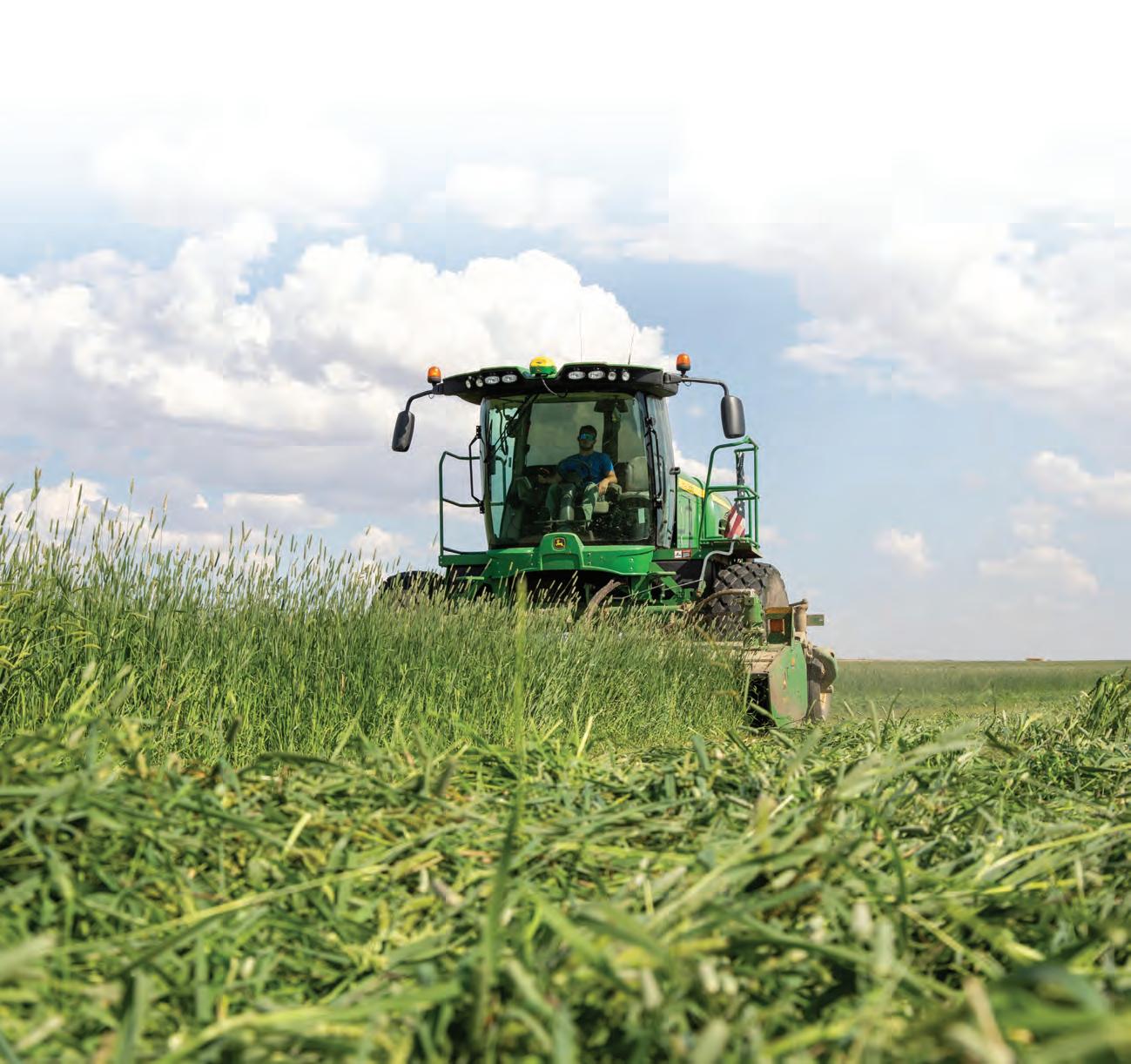
Stevens’ life story doesn’t include inheritance. He’s a first-generation hay farmer.
“I didn’t grow up around farming at all,” Stevens noted. “I did do some farming work for my uncle. After high school, I went to tech school for electronics, but after I got out, I came back to work at my uncle’s farm for $1,000 a month. After a few years of that, it made me hungry to do something on my own.”
Stevens continued his early life tale, “I made a deal to buy broken bales from my uncle and purchased five beef cows. From those five cows, I just kept growing. My uncle provided me with an education that was irreplaceable,” he added.
Stevens broke away from his uncle’s employment when he was 28 years old and started leasing hay ground. With help from a kind-natured banker, Stevens bought a used tractor, baler, and swather — all with borrowed money. He eventually purchased a used bale wagon, or “harrow bed” as they’re referred to in that region. “I did custom work for other people and any other work I could find to stay solvent,” Stevens said of those early years. “I then started buying some land and eventually bought this farm in the early 1990s, which at that time had about 100 acres, but it wasn’t all irrigated. My cow herd was still growing, too.” Stevens had about 120 brood cows before he decided to sell the cattle to help buy more hay acres. He preferred making hay to caring for livestock. Ever since, the number of owned and leased hay acres have just kept mounting. “I never had a cosigner on a loan, but I got a lot of
6 | Hay & Forage Grower | March 2023
A second cutting of timothy is cut last August. Stevens Hay Farms harvests about 10,000 acres of timothy each year.
help and advice from neighbors along the way,” Stevens said with a tone of appreciation. “I couldn’t have got to this point without them.”
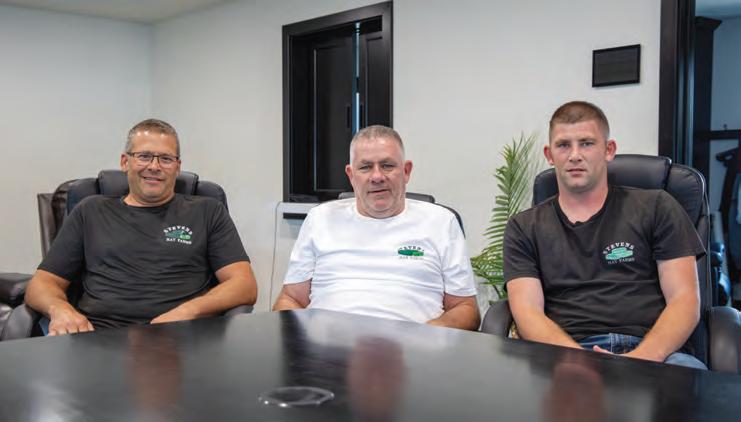
Family and then some
Stevens’ children have all been involved in the operation while growing up and as adults. Kye, his oldest son, heads up Stevens Domestic Hay Sales. He and his wife, Lindsey, who also helps on the farm, recently became new parents. Hay sales within the U.S. include retail feed stores and dairies.
Steven’s oldest daughter, Brynna, oversees the hay harvesting operation. Her husband, Teddy, works on the hay export marketing side of the business. Another daughter, Berlyn, operates equipment when she can but is currently studying to be a veterinarian. “She’s the best machine operator we have,” said Stevens, who also has two younger children, Dezi and Brady, who are just starting to help out.
The base of operations is a 3-year-old office building that’s located among the plethora of machine sheds and haystacks located at the farmstead. To the east of the office is a building that houses Stevens Hay Exports LLC. Stevens is a 50% partner in the 4-year-old export business venture. Jason Gunderson, who has many years of hay export experience, serves as the CEO for the export business but is also involved in all facets of the farming operation. With many moving parts, Stevens emphasized that although there are designated responsibilities, everyone pitches in wherever needed. “Sometimes, our secretaries are out running the balers,” he chuckled.
Clean and green
Stevens Hay Farms will harvest about 10,000 acres of alfalfa and 10,000 acres of timothy in 2023. The region receives about 7 inches of rain per year, so irrigation is a must. Hay is harvested within about a 50-mile radius of home base.
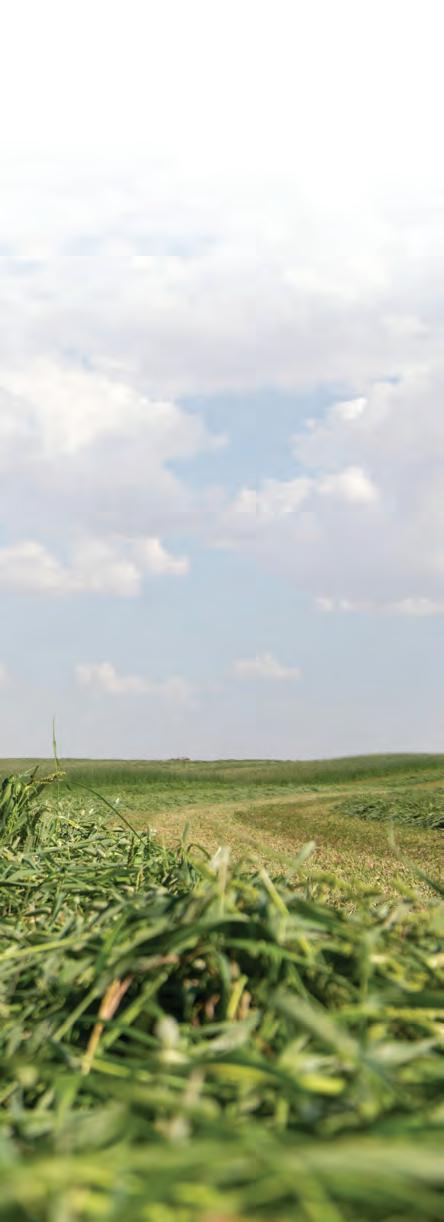
Alfalfa is generally seeded in the late summer with a target to have all new seedings in the ground by September 1. The soil is lightly tilled — more like scratched — before seeding and then planted with a Great Plains no-till drill or an air seeder at a rate of 20 pounds of seed per acre.
Raptor herbicide is applied to new seedings around October 1 to control any weed issues. When asked about the need for a fall herbicide treatment, Gunderson said, “There are so many exporters out here that it becomes a beauty contest. Your hay has to be clean and green to have a chance at competing.”
Generally, alfalfa is cut three to four times per year. In a normal year, cutting begins around the middle of May. Stevens likes to cut alfalfa about every 32 days and finish by the end of August. Stands are kept for four years and then are rotated out of alfalfa for at least three years before being reseeded back to alfalfa. Timothy is used as the primary rotation crop, although sometimes potatoes or dry beans are planted either by Stevens or another vegetable grower.
Timothy establishment is similar to
alfalfa — in the late summer after a marginal stand of alfalfa is sprayed out. Three cuttings are taken the first production year with the final cutting harvested the last half of September or early October. “I like an aggressive cutting schedule for our timothy to achieve high quality and to get it off before leaf diseases become a problem,” Stevens noted.
Timothy stands are kept two to four years, depending on when other weedy grasses begin to infiltrate stands and how long the field had been out of timothy before the new seeding was established.
To keep phosphorus and potassium soil fertility in line, Stevens’ preference is to use dry, composted manure, which he purchases from a local distributor. He will also use manure from a nearby feedlot. For alfalfa, the compost is applied at the time of seeding and after the final cutting each year. Commercial nitrogen fertilizer appli-
continued on following page >>>

March 2023 | hayandforage.com | 7
Jason Gunderson (left) is the CEO for Stevens Hay Exports. Bill Stevens (center) has grown his business to a 20,000-acre, vertically integrated operation. Kye Stevens (right) oversees Stevens Domestic Hay Sales.
Composted manure is sourced from a local provider and is Stevens’ preferred product for maintaining phosphorus and potassium fertility.
All photos Mike Rankin
cations are made on the timothy acres. The farm does all of its own fertilizer and chemical applications.
As one might imagine, the equipment line to harvest Stevens’ volume of acreage is extensive and includes seven John Deere 16-foot self-propelled mower-conditioners; nine Twinstar basket rakes; eight New Holland large square balers, which are traded every year; eight Hesston inline 3-tie balers; and 23 semitrucks. Stingers and New Holland bale wagons are used to pick up bales. Stevens also often calls on custom operators to help with baling and bale transport from the field.
“I like the adjustment options on the basket rakes,” Stevens said. “We can manipulate windrows in a variety of ways.” Hay is usually raked twice, always early in the mornings when there’s still dew.
Vertically integrated
The large pole building that houses Stevens Hay Exports is equipped with two Hunterwood bale presses. The business also has a USDA-certified fumigation facility. A lot of Stevens Hay Farms’ timothy goes to South Korea and Japan. China is their main export partner for alfalfa. “Stevens Hay is the largest organic alfalfa producer for China in Washington,” Gunderson noted. “We produce about 5,000 acres of organic hay each year.”
Gunderson said that being a totally integrated operation has many advantages. “Our export customers like that we grow our own crop,” he said. “It’s also more profitable for us. We have trucks going to the Seattle-Tacoma port every day of the year. The shipping container situation is getting better.”
The knowledgeable hay exporter
“China is a growing alfalfa market,” he said. “West Coast alfalfa is the best in the world. Exports have been strong, but what scares me is that high prices push these countries to look for other options. We may have hit the ceiling on hay prices.”
In addition to export and domestic hay sales, the operation also utilizes a nearby feedlot to take chaff generated from the hay presses and the lower quality hay that sometimes gets made.

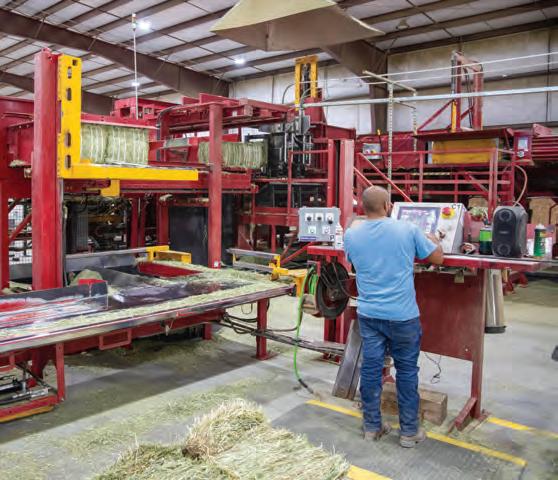
A bright future
The growth curve for Bill Stevens’ hay businesses continues on an upward trajectory, although he’s starting to step back and let his trusted family members and employees take the reins. “I look at things more from the 60,000foot level now,” he said.
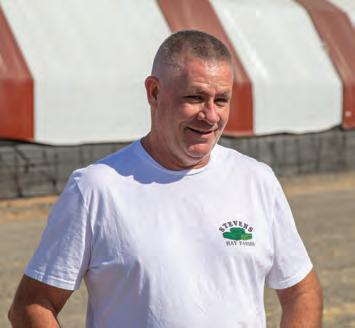
And why shouldn’t he? It’s been a long road from five cows and paying a discount price for his uncle’s broken bales.
continued, “It’s important to have as many outlets as possible for our hay.
Traditional markets like Japan and South Korea are shrinking. For Japan, the timothy goes to the dairies and beef operations. The really high-end timothy goes to the horse farms. The company also exports some grass straw.
Stevens has a well-positioned management team in place with lifelong experience in the business of making and selling hay. He also has dedicated employees. “I say it every year at our Christmas party,” Gunderson said, “When there’s work to be done, everyone around here just jumps in and goes. That’s the kind of environment Bill has built around here.”
It could also be that there’s something in the water. •
8 | Hay & Forage Grower | March 2023
Trucks take compressed hay bales to the Seattle-Tacoma port every day. Stevens Hay grows and exports about 5,000 acres of organic alfalfa.
Two Hunterwood bale presses operate in the building that is home base for Stevens Hay Exports. There is also a USDA-certified fumigation facility on site.
Bill Stevens is quick to give credit to his uncle and neighbors for providing help and education as he built his business over the years.
Soil health’s biological basis

CAN soil really be considered healthy or unhealthy? Wouldn’t that require soil to be a living entity? How could this be if soil is made up of sand, silt, and clay particles and simply holds water and air as a medium for anchoring plants to the earth?
Well, soil could be considered unhealthy if it no longer performs the essential functions of absorbing water, filtering water to give us clean groundwater, providing nutrients to allow plants to thrive, or decomposing organic materials applied to the land. Indeed, soil can be considered healthy only if it can perform these essential functions that we expect from it. How we manage soil, therefore, allows us personal control for the health of our land. This is a great responsibility that can be rewarding for us and our neighbors.
Measured breathing
When we consider soil a living entity, we can understand that it breathes much like we do. Although soil may be truly living only in the bacteria, fungi, and small animals that reside within the mineral matrix, it acts as a living entity through the multiple functions it performs for the benefit of the earth’s inhabitants. Therefore, the more soil breathes, the more it needs to be fed. The more soil is fed, the more work it can do. We can measure this breathing through soil respiration, which is the exhaling of carbon dioxide (CO 2) from the soil surface.
To standardize this measurement as a soil testing approach, soil is collected, dried, and then rewetted to optimize the balance of water and air for soil microorganisms. Placing the moist soil in a chamber with constant temperature is important, as cold soil doesn’t respire as much as warm soil if all other factors are the same. After only a few days, the amount of CO2 respired can tell us how biologically active a soil sample might be.
Some soils are more biologically active than others. Those samples that are more biologically active can be considered well-fed, highly functioning soils. These soils might be considered health-
ier than those having little biological activity. When a soil has very low biological activity, can it really be considered healthy enough to support a robust plant community that provides us sufficient food, fiber, and ecosystem services?
Standard measures
Because of the sensitivity of soil biological activity to temperature, moisture, and length of time, a standard laboratory approach is needed. With years of experience as a foundational basis, soil-test biological activity (STBA) has become the standard to which other laboratory protocols should be compared. These technical details become important when making recommendations for nutrient management or interpreting the effects of soil management on other ecosystem services.
Soil-test biological activity was recently categorized into a gradient of low and high levels to make nitrogen fertilizer recommendations (see figure above; https://bit.ly/HFG-Nrec).
This gradient of STBA allows producers to make immediate decisions on nitrogen application rate, as well as providing a useful indicator to assess long-term changes in soil health condition when sampled periodically. Since the inherent ability of soil to provide
nitrogen to growing plants is a function of a small portion of soil organic matter turnover, STBA, expresses this vital soil process effectively.
Grass enhancement
Soil-test biological activity has been shown to improve with pasture age. This is due to the accumulation of organic matter near the soil surface with input of roots and their partial decomposition over time.
Return of plant residues or livestock feces also feeds soil microorganisms. Type of soil and environmental conditions can also affect STBA. Therefore, different types of management can either increase or decrease STBA, depending on landscape setting.
Evidence is becoming clear that routine soil testing for inorganic nutrients may need to be supplemented with soil biological testing. •
SUNRISE ON SOIL by Alan Franzluebbers
ALAN FRANZLUEBBERS
80 60 40 20 0 Nitrogen factor (lb N ton -1
The author is a soil scientist with the USDA Agricultural Research Service in Raleigh, N.C. Soil-test biological activity (mg CO2-C kg -1 soil 3 d -1) 0-4” depth
Soil biological activity impacts need for nitrogen 0 100 200 300 400 500 600 Frazluebbers et al., 2022
forage) VL L M H VH March 2023 | hayandforage.com | 9
HORSE OWNERS HAVE THEIR SAY ON HAY
by Krista Lea
IN A recent survey of horse owners, 48% said alfalfa hay was an excellent source of nutrition while 73% said it was too high in protein or overall nutrients (Figures 1 and 2). These results represent conflicting opinions.
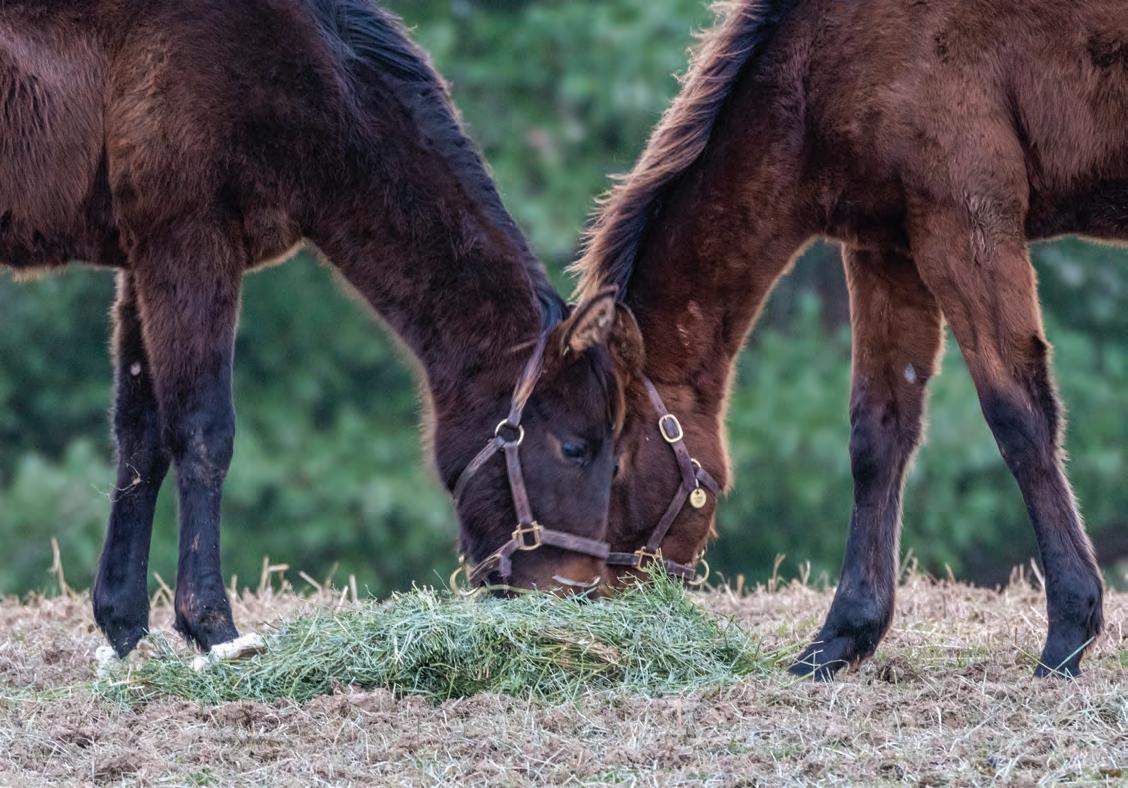
Hay producers across the U.S. have experienced a similar disconnect when marketing to the horse industry. As a horse owner and a forage agronomist at the University of Kentucky, I’d like to shed some light on how to market hay to horse owners and tap into this lucrative but fickle market. The truth is that horses come in a variety of sizes, shapes, and uses, and with this much variation comes differences in
nutritional needs as well as owner expectations. To successfully reach this clientele, you have to satisfy both. From a forage quality perspective, horses aren’t all that different than cattle. Energy is typically the most limiting factor, and we need to try to target higher energy hay with horses that require a higher energy diet. Similar to a lactating cow, a lactating horse or a horse doing heavy work is going to require energy and nutrient-dense hay such as alfalfa. But a mature, idle horse will require far less energy.
Gain can mean pain
One significant difference in cattle and horses is the ease at which horses can become over-conditioned. Overfeeding horses can lead to obesity and a
slew of metabolic disorders that can be career- or life-ending. So, horse owners are just as concerned with meeting nutritional needs as they are exceeding nutritional needs.
Unlike most other agricultural species, gain is not always a good thing, and appropriate hay will, in most cases, maintain body condition instead of increase it. For horses, high-quality hay is considered to be free of weeds, dust, and mold, and when fed at sufficient amounts to match intake requirements (usually 1.5% to 2.5% of body weight), meets the nutritional needs of the horse without exceeding it.
The idea of an “idle” animal is also somewhat unique to horses. Most cattle farmers are encouraged to cull any animals that aren’t being productive. But
10 | Hay & Forage Grower | March 2023
Jimmy Henning
Alfalfa hay has its place in a horse diet, just not all horse diets.
because a horses’ value isn’t in their pound of flesh, bigger isn’t better. A horses value is in their genetics, their performance or the work they do. And in some cases, their value is intrinsic; the joy and friendship they bring far outweigh any monetary value they might have.
Beyond nutritional needs, how do horse owners select hay? The same survey that found the conflicting data presented earlier also revealed a few other things that might be beneficial in answering this question. The survey study, which was funded by National Alfalfa and Forage Alliance checkoff dollars, was conducted by researchers at the University of Kentucky in the Departments of Animal and Food Sciences and Plant and Soil Sciences with the goal of better understanding hay-buying preferences of horse owners.
The first group of questions asked whether or not horse owners like to feed alfalfa (or alfalfa mixed hay) and why. Many said they both liked to feed it and didn’t like to feed it, which was probably due to different needs for different horses. For example, I currently have four horses in my barn consuming alfalfa hay: two yearling fillies actively growing, one broodmare near parturition, and one old, very picky retired mare. The rest of my barn, consisting of mostly retired geldings, maintain their body weight quite well on what most hay producers would call low-quality hay — straight grass, slightly over mature, and stemmy. I, too, would be one to answer: Yes, I prefer to feed alfalfa hay, and no, I don’t prefer to feed it. It depends on the horse.
More than price
In another question, horse owners were asked to rank what factors are most important to them when purchasing hay. The factors listed included bale size, quality analysis, cost, dealer reputation, and availability of delivery. Cost ranked first, which was not surprising. But the second most important factor was dealer reputation. It was important to know that friends were satisfied with their hay purchase. Horse owners want to be sure that price reflects the quality of the product, and that the seller is willing to stand behind their hay if there is a problem. All of these were more important factors than a guaran-
teed analysis of the hay. Like many aspects of agriculture, word of mouth is the ultimate advertisement. Every hay supplier that I purchase from simply says, “If they don’t eat it, I’ll come back and get it.” And they have.
Small bales preferred
The third most important factor was bale size. While many hay producers are moving to larger bales for handling and trucking ease, they also need to remember that the end horse user could be a small woman, feeding one or two horses, who would prefer a 40-pound bale she can pick up over a more economical 75-pound bale. Often, there isn’t the space or equipment to even consider 3x4x8-foot large square bale. Horse owners were also asked where they get their hay-buying information. Of the 10 choices they were given, university personnel ranked first. Second was the hay supplier, which was somewhat surprising. This means that horse owners value the hay supplier’s guidance more than most other sources of information, including extension publications, their veterinarian, and the internet. Understanding the needs of the clients and their horses gives hay suppliers a tremendous advantage
because horse owners clearly value their knowledge and guidance. It’s advantageous for hay suppliers to get to know their clients, which is an easy task because horse owners love to talk about their horses.
Most horse owners aren’t nutritionists, agronomists, or money managers. They know their horses and desire the correct feed for them. If hay suppliers and producers take the time to get to know their horse clients (human and horse alike), provide them with the quality of hay they require in a package they can handle, and stand by that product, they will be rewarded with a loyal clientele willing to pay a premium for hay that suits their needs.

March 2023 | hayandforage.com | 11
•
KRISTA LEA
The author is a research analyst and horse pasture evaluation program coordinator with the University of Kentucky.
60% 40% 20% 0% Responses Good source of nutrients Good palatability Excellent value Have always fed it 48% 32% 12% 9%
50% 40% 30% 20% 10% 0% Responses Nutrient content too high Protein is too high Mold and dust concerns Blister beetle worries 40% 33% 17% 10%
Figure 1. Why do you feed alfalfa hay?
Figure 2. Why do you not feed alfalfa hay?
The author wishes to thank Bob Coleman, an extension equine specialist at the University of Kentucky, for his role in helping develop and distribute the survey.
Time for interseeding
THE Year of the Great Inflation is how many people will remember 2022. Among the numerous things that inflated in 2022 was the price of nitrogen fertilizer. It seems every time the nitrogen price goes up, there is a surge of interest in interseeding legumes in pastures and hayfields. Should times of high fertilizer prices be the only time we think about legumes as a nitrogen source for our pastures?
My experience has been that nitrogen fertilizer hasn’t been economically competitive with legumes in a pasture for at least 40 years. I have already made this point in this column a few years ago. In the 23 years we were on our farm in Missouri, there were only three occasions that we ever used nitrogen fertilizer on a pasture. We are approaching 19 years on the ranch in Idaho, and it has been nine years since any kind of fertilizer has been applied to these pastures. The only time nitrogen has been applied had been as a tag-along with phosphorus being applied as 11-52-0 every three or four years.
Always a benefit
Whether fertilizer is expensive or not, it makes sense to grow legumes in your pastures wherever and whenever it is feasible. A mixed grass-legume pasture provides better balanced nutrition than either a grass or a legume monoculture. Numerous studies have shown superior animal performance with mixtures compared to monocultures. Aboveground plant diversity increases belowground biodiversity to the benefit
of soil health. Many pollinators enjoy legume blooms. Oh, and there is the nitrogen-fixation benefit as well.
Since most pastures around the country are deficient in legume content, it is time to think about how and when to interseed them to gain all those benefits. We have a few options that we have found to be successful in different environments.
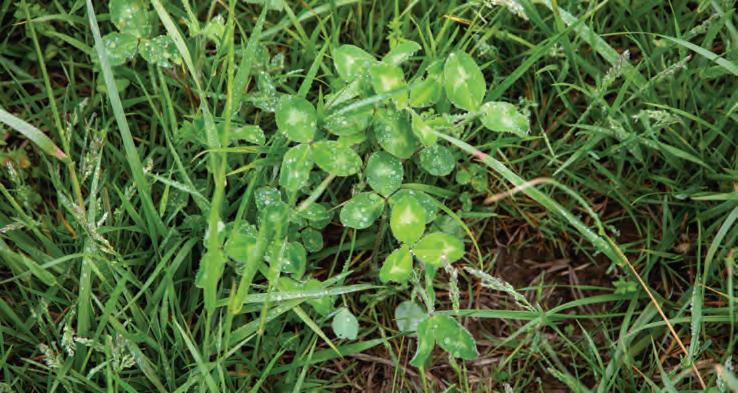
Frost seeding is a broadcast seeding method that works well for most smallseeded legumes in regions that have regular freeze-thaw cycles in late winter or early spring. There is often concern about seed-soil contact with this method. If a pasture has been stockpiled for winter grazing and then is strip-grazed, seed-soil contact is usually adequate. If a pasture has all of its fall residual left intact, then dragging the pasture can help get seed down to the soil.
Reliable spring moisture is also a necessity. That can either be as natural precipitation or through irrigation. In an irrigated environment, it is important to make sure to keep the newly seeded area moist. We have seen many overseedings germinate on the natural moisture but then wilt when irrigation is not begun in timely manner.
Go with late snow
Another broadcast method that we have had good success with is seeding on top of a late snow. We don’t like seeding over the long winter snow cover. That type of snow often melts off the top, and broadcast seed can be washed away
with snow melt water flowing across the crusted snow or ice sheet below.
Once the winter snow cover has melted off and the ground has thawed somewhat, that’s when it’s time to be ready for your spring legume overseeding. When you get a new snow cover, get out there and start broadcasting seed. One big advantage of broadcast seeding in this situation is that you can actually see your wheel tracks and do a more uniform seeding job. The darker legume seed absorbs heat and “burrows” down into the snow. Most of these later snows melt from the bottom up. In the process, the melt water typically infiltrates and doesn’t run off. The seed can literally be sucked into the soil surface.
There are some situations where a no-till drill actually makes more sense than broadcast seeding. We generally budget broadcast seeding at $4 to $6 per acre while no-till drilling may range from about $15 to $28 per acre. That is a big cost difference for getting your seed out there, but there are some legumes that establish more consistently when drilled compared to broadcast seeded. Those legumes needing special seeding attention in many environments include both alfalfa and birdsfoot trefoil. I have seeded both of those legumes successfully by the broadcast method but less consistently than most clovers have established over the years.
We also find a no-till drill to be more consistent for irrigated pastures with very low natural rainfall. In this situation, we generally plan to drill the seed within a few days of beginning irrigation. This works very well with any sprinkler system. Broadcast seeding often performs poorly on flood-irrigated ground as seed may wash away with the first surge of flood water.
Legumes are valuable components in almost every pasture situation. In a good part of the U.S., late winter and spring is the seeding season. Get your seed early and get it in the ground in timely manner. •
JIM GERRISH
The author is a rancher, author, speaker, and consultant with over 40 years of experience in grazing management research, outreach, and practice. He has lived and grazed livestock in hot, humid Missouri and cold, dry Idaho.

THE PASTURE WALK by Jim Gerrish
12 | Hay & Forage Grower | March 2023
Mike Rankin
By Paul Schneider Jr., AG-USA (This is a paid advertisement)

We have been fearfully and wonderfully made! When given perfect conditions, our bodies can be quite healthy, yet we know they are able to exist in less than optimal conditions.
Plants are the same way. They are able to survive in far less than optimal conditions, but the resulting biological and nutritional deficiencies greatly compromise a plant’s ability to defend itself against parasitic bacteria, harmful fungi, and insect invasion.
When plants are given optimum living conditions - when they have extra resources to work with, they go from just surviving to thriving.
The fact is, it takes a healthy plant to create a healthy soil. When a plant is barely surviving, its resources are very precious. It must retain most of its resources for building plant structure; little can be spared to feed its microbial partners in the soil.
Health Level One
Mycorrhizal fungi have a vested interest in keeping the plant alive. The very existence of these fungi depends on a symbiotic relationship with the plant, where the plant secretes sugars to feed them, and they, in turn, provide nutrients to the plant.
There is a vast amount of phosphorus in most soils. When phosphorus is not available, plants will sequester sugars to feed mycorrhizal fungi, and they, in turn, are highly effective at making tied-up phosphorus in the soil available, and carrying it to the plant. When it is given water-soluble phosphorus, the plant no longer needs mycorrhizal fungi to make phosphorus available. The plant becomes far less motivated to feed the mycorrhizal fungi, resulting in primary mycorrhizal structures never being established.
Sequestered sugars result in higher carbohydrate levels in the soil. These carbohydrates will help a plant protect itself against soil borne pathogens.
Mycorrhizal fungi also help transport moisture back to the plant. This helps the plant stay green during dry spells. This means more photosynthesis and more manufactured sugars.
Health Level Two
As mycorrhizal fungi increase, they build fungi networks in the soil. The fungi share plant sugars with beneficial bacteria. The fungi actually colonize the bacteria.
The bacteria then help break down nitrogen, making it available to the plant. They “weather” bedrock to extract minerals, which the fungi then transport to the plant. Through all of their functions, these bacteria help increase the immunity of the plant.
Mycorrhizal fungi are all too happy to work together with beneficial bacteria, because by working together they can do more to ensure the survival of the plant, and thus, their own survival.
As fungi partner together with bacteria, the plant is able to build extra proteins on the surface of the leaf, giving the plant much greater protection against sucking and chewing insects
MycorrPlus provides trace minerals that play a key role in protein synthesis. It also helps establish healthy soil conditions that help establish greater mycorrhizal fungi networks in the soil.

Health Level Three
Amino acids are the building blocks of proteins. At level three, mycorrhizal fungi create a mucous layer, a type of sheath, that surrounds fungal hyphae. This provides a
means for bacteria to move around in the soil.
At this level of complexity, the microbes in the sheath are able to digest amino acids, turning them into proteins, saving the plant the need to create these proteins.
Without the mycorrhizal sheath around roots, the plant finds it hard to properly use amino acids to create proteins, resulting in an excess of soluble amino acids in plant sap. This draws sapping insects and pathogenic fungi.
When mycorrhizal fungi help with the work of building proteins, the plant is able to conserve a lot of energy. It uses this energy to produce greater amounts of resistance metabolites. These result in an even greater level of fungal infiltration into the soil.
At level three, nitrogen combines with plant sugars to create fatty lipids. This results in secondary plant metabolites that provide increased immune function against air-borne pathogens
A primary sign that a plant has reached level three of health is that the lipids and proteins create a waxy surface on the leaves, making them glossy.
Numerous MycorrPlus customers have commented that within 6 to 12 months, the leaves of their plants have become glossy. Please call toll-free today and ask for a free information packet or contact our West Coast office!
Conquer Nature by Cooperating with it
Like a center pivot for dryland farmers! Reduces the need for LIME and other fertilizers
MycorrPlus is a liquid bio-stimulant that helps to remove compaction by highly structuring the soil. It creates something like an aerobic net in the soil that retains nutrients and moisture. It contains sea minerals, 70+ aerobic bacteria, 4 strains of mycorrhizal fungi, fish, kelp, humic acid and molasses. $20 to $40/acre.
To learn more, call (888) 588-3139 Mon. - Sat. from 8 a.m. to 10 p.m. EST. Request a free information packet or visit: www.AG-USA.net Organic? Use MycorrPlus-O.
TM
Plus
National office: AG-USA, PO Box 73019, Newnan, GA 30271. (888) 588-3139 info@ag-usa.net West Coast office: Global Restoration LLC, 1513 NW Jackpine Ave., Redmond, OR 97756. (541) 788-8918 wcoast@ag-usa.net
SELF-FED ENSILED FORAGE REDUCES LABOR COSTS
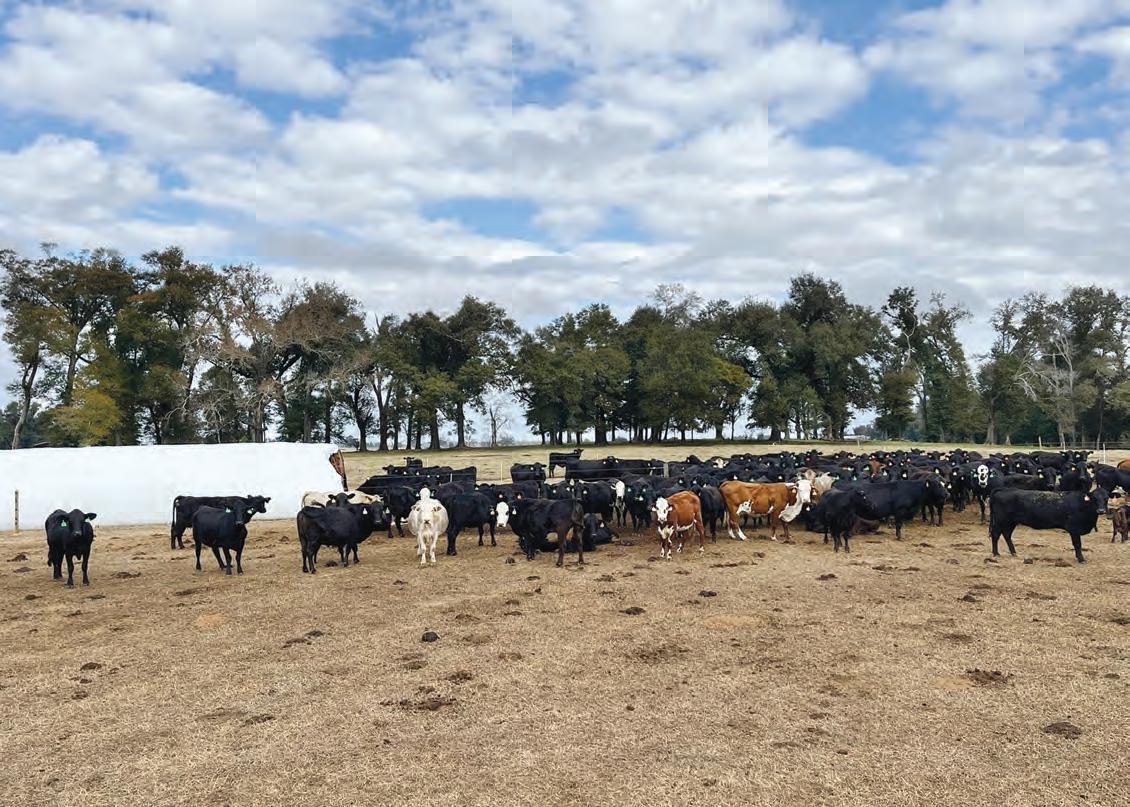 by Nicolas DiLorenzo, Federico Podversich, and Federico Tarnonsky
by Nicolas DiLorenzo, Federico Podversich, and Federico Tarnonsky
THE development of forage harvesting equipment and silage bags has improved and facilitated the preservation of forages as silage. This technique allows us to preserve the excess forage production of the summer to bridge the gap during forage shortages. Additionally, ensiling forages offers a reduced weather risk and allows for greater quality feed compared to dry hay. However, labor and equipment costs can mount as larger volumes of silage are preserved and fed.
Farm labor availability has been on a long-term decline while wages and other input costs continue to rise. This situation pressures ranchers to come up with alternative solutions to keep up with production and profitability. Therefore, cattle producers continue to implement strategies that require less workforce while main-
taining productivity.
One option being explored at the North Florida Research and Education Center (NFREC) is the use of “self-feeding” silage bags. The use of self-fed ensiled forages is a suitable alternative for producers who want to reduce input costs such as equipment use and labor. This is a low-cost approach in which cattle are allowed to eat silage free choice from a silage bag.
The bag is opened on one end with electrified wires running across the opened face of the silage bag. The sides of the bag are also fenced off. This approach can be implemented on a small or large scale and can be used for both growing and mature cattle. While there is no individual control of the silage intake, this free-choice approach system reduces the need for tractors, feed wagons, or diesel fuel. In today’s economy, such savings can be appealing. Nonetheless, there are different aspects to consider when deciding to use a self-feeding silage bag, as farm
situations differ and the feeding operation must be tailored to fit.
Pick a dry site
Silage bags should be located in a well-drained location to avoid excessive mud accumulation. Normally, the location of the silage bag would be dictated by the layout of existing facilities such as feeding yards, but if no infrastructure exists, the preferred area would be an elevated terrain to take advantage of the natural water drainage. In such cases, we recommend to position the silage bag on the slope. Feed animals downslope from the bag so that urine, rainwater, and feces run off away from the face of the silage.
Ideally, the bag should be opened facing south, as this will provide maximal sunlight exposure and keep the ensiled material and the soil surface dry. It is advisable not to place the silage bag under trees. It is also important to fence off the sides to prevent cattle access to the bag. This can be done with
14 | Hay & Forage Grower | March 2023
Researchers at the University of Florida are fine-tuning ways to feed silage directly from a bag. These cows were self-fed during calving season.
an electric fence, taking advantage, whenever possible, of existing perimeter fences to reduce costs.
Maintain adequate feedout

Once the bag is opened, oxygen penetrates the ensiled forage, and this allows yeasts to grow and cause spoilage. Therefore, allow cattle to consume enough material every day so it does not spoil and waste. This is called the face removal rate or daily frontal advance. As a rule of thumb, it is recommended to remove at least 1 foot off the silage face per day in the winter and 1.5 feet during summer so that fresh silage is always being fed.
This rule of thumb may be flexible depending on location and climate. The face removal rate goes hand-in-hand with the number of animals stocked with the self-feeding silage bag. Additionally, the use of heterofermentative inoculants during the ensiling process can delay the growth of yeast once the feed is exposed to oxygen, extending the aerobic stability of the silage.
The easiest way to control cattle’s frontal advance into the bag is with the use of electric fence. Cattle learn quickly how to eat silage from the front of the bag while respecting the hot wire. There are also other more sophisticated options to restrict access to cattle such as hurdles or feeding gates, but those require a greater investment and are harder to manage. However, these options could reduce waste. The gates should be easy to move (many farmers use wheels attached to the structure to push the gates), keeping in mind that cattle should be allowed a fresh portion of silage every day as it is being consumed.
Each day, remove a “slice” of the plastic bag and move the hot wire closer to the face, allowing cattle access to new feed. This can quickly be done by one person, and the tools needed for the daily care are a pocketknife and a pitchfork (to pile up any loose silage in the bottom and push it behind the wire). The savings in time, diesel fuel, and tractor use can compensate for any feed waste generated with this feeding strategy.
Stock appropriately
The ideal stocking rate will depend on the size of the bag, moisture content,
packing density, and face removal rate. Roughly, stocking rate can vary from 50 to 100 head per bag, depending on the animal category being fed. Our experience with the 12-foot bagger used at the NFREC has shown a packing density of around 2 to 2.1 tons per linear foot of bag for corn and sorghum. With that packing density, we have been able to feed at least 45 mature cows. We can remove the previously mentioned 1 foot off the frontal face of the bag to minimize spoilage due to oxygen exposure and continuously offer fresh silage to the animals.
therefore, protein supplementation is required. Without enough protein in the diet, cattle will waste some of the fibrous portion of the feed because the rumen bacteria cannot fully degrade it. The exception can be ensiled winter annuals or legumes; these forages can have adequate levels of protein, but this needs to be confirmed with a feed nutrient analysis. In a study conducted recently at the NFREC, a reduction of 40% in body weight gain was observed in growing heifers self-fed corn silage without protein supplementation compared with heifers fed corn silage plus 10% cottonseed meal on a dry matter basis (2.5 pounds per day).
The most common forages ensiled in our area are corn and sorghum (forage or grain hybrids). These silages provide high energy due to their starch content when harvested at the right maturity. Perennial warm-season grasses and winter annuals can also be ensiled but require wilting to reduce moisture.
If a greater “slice” is offered, for example 2 linear feet per day, more animals can be fed. However, if we exceed this number of animals accessing the silo, some animals will become competitive and keep others from maintaining adequate feed consumption. To ensure that all animals have access to the silage bag, and that competition is minimized, it is recommended to have homogeneous groups of animals eating from the same bag. Therefore, avoid mixing, for example, weaned calves with mature cattle. A good, practical indicator of a correct stocking density is to see all cattle in the paddock resting at the same time with no anxious feeding behavior. Weighing the animals every few weeks or monthly can help determine if the target gains are being achieved.
Ensure nutritional needs
If intending to utilize silages for growing cattle, remember that most ensiled forages (with the exception perhaps of winter annuals or legumes) are typically deficient in protein;
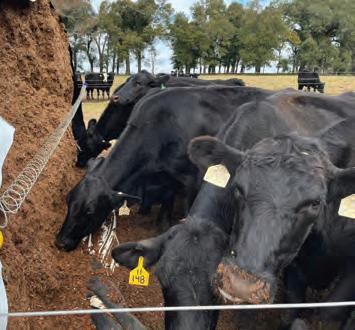
In the case of cow-calf operations, self-feeding silage bags of warm-season perennials like limpograss or bermudagrass can be utilized to feed mature cows during periods of grass shortage, avoiding the need to feed round bales. Another interesting strategy is to allow cattle some hours of grazing of winter grasses during the day and placing them at night in a pasture with a self-feeding silage (corn or sorghum) bag. With this management, the winter grass provides high levels of protein that helps utilize the energy from the silage.
In summary, self-feeding ensiled forages can be a useful strategy for cattle operations, mainly due to reduced costs in labor and equipment. Different forages can be utilized, and nutrient deficiencies should be corrected depending on the requirements of the animals to be fed. If managed properly, minimal losses can be expected from this feeding system. •
March 2023 | hayandforage.com | 15
NICOLAS DILORENZO DiLorenzo (pictured) is a professor and extension beef specialist with the University of Florida and based in Marianna. Tarnonsky and Podversich are graduate research assistants.
Mature cows learned to respect the electric wire and were self-fed sorghum silage from the frontal bag face.
Control hay heating by wrapping lower moisture bales
Hay & Forage Grower is featuring results of research projects funded through the Alfalfa Checkoff, officially named the U.S. Alfalfa Farmer Research Initiative, administered by National Alfalfa & Forage Alliance (NAFA). The checkoff program facilitates farmer-funded research.
FARMERS attempting to bale dry hay while fighting weather that is too wet and/or too cool for drying to 15% to 17% moisture may have another option.
Alfalfa Checkoff-funded research found that wrapping relatively dry mixed-forage round bales with plastic film cuts off the crop’s oxygen supply, stops respiration, and preserves the forage as minimally fermented baled hay. “The large hay packages commonly used today are particularly prone to spontaneous heating, resulting in dry matter losses, poorer nutritive value, and, in extreme cases, spontaneous combustion,” said former USDA-ARS research dairy scientist Wayne Coblentz.
“It was striking the heating control we got in those bales with the elimination of respiration by simply restricting air access with plastic,” he added. Coblentz, recently retired as research leader at the U.S. Dairy Forage Research Center based at Marshfield, Wis., conducted the experiment with Matt Akins, who now holds that position, and Burney Kieke, a biostatistician with the Marshfield Clinic Research Institute.
PROJECT RESULTS
Wrapping relatively dry mixed-species forages with plastic film proved extremely effective in reducing spontaneous heating during storage and minimizing nutrient losses. This approach offers considerable promise as an alternative management option for preserving forages when uncooperative weather prevents baling at a moisture level suitable for safe storage as dry hay.
The colleagues compared alfalfa-orchardgrass forage baled in 5-foot diameter round bales at 25% moisture under four scenarios. Bales were wrapped with seven layers of plastic, treated with a propionic acid-based preservative and wrapped in plastic, left unwrapped but treated with propionic acid, or left unwrapped without preservative.
Each bale was weighed, core-sampled, and stored for 84 days before plastic was removed from wrapped bales. All were then again weighed and core-sampled. Moisture concentrations, pH, and nutritional values were measured, as well as the fermentation within wrapped bales evaluated.
“People still would like to bale dry hay for all kinds of different reasons, but it’s often difficult to get material as dry as it needs to be before baling in the North Central region,” Coblentz explained. “With hay packages larger in size, the problem of spontaneous heating and associated losses of dry matter and nutritive value have increased.”
The researchers had noticed a recent trend toward baling silages drier than 50% to 60% moisture, and some of
their other experiments had successfully baled forage crops at fairly low moisture concentrations (30% to 35%). Coblentz added, “With this specific experiment, we asked: ‘If we can get this hay down to 25% moisture, what happens if we just wrap it in plastic? How effective would that be?’
“It turns out it was very effective,” Coblentz said.
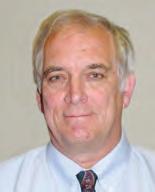
Less heating
Wrapped bales, whether treated with preservative or not, reduced heating and minimized nutrient losses. “Because there was little moisture in these bales, they didn’t ferment very much, which means basically you’re preserving them by excluding air,” he added.
Unwrapped bales accumulated considerably more heating units throughout storage, regardless of whether they were treated with a preservative or not. However, acid-treated unwrapped bales accumulated fewer heating units at 30 and 45 days post-baling, and dry matter recovery was improved significantly compared to unwrapped bales without preservative.
16 | Hay & Forage Grower | March 2023
YOUR CHECKOFF DOLLARS AT WORK
Effect of wrapping on bale heating 800 700 600 500 400 300 200 100 0 Heating degree days > 30 o C Wrapped Unwrapped 30 days45 days84 days30 days45 days84 days WAYNE COBLENTZ Funding: $13,335
After 84 days of storage, the wrapped bales had plastic removed and were monitored for another 33 days for aerobic stability. “This is where propionic acid has really shown a lot of benefit. The exposed, fermented bales that were treated with preservative exhibited characteristics that were consistent with improved
SUPPORT THE ALFALFA CHECKOFF!


Buy your seed from these facilitating marketers:
Alfalfa Partners - S&W
Alforex Seeds



America’s Alfalfa
Channel
CROPLAN
DEKALB
Dyna-Gro
Fontanelle Hybrids
Forage First
FS Brand Alfalfa
Gold Country Seed
Hubner Seed
Innvictis Seed Solutions
Jung Seed Genetics
Kruger Seeds
Latham Hi-Tech Seeds
Legacy Seeds
Lewis Hybrids
NEXGROW
Pioneer
Prairie Creek Seed
Rea Hybrids
Specialty
Stewart
Stone Seed
W-L Alfalfas
aerobic stability, and that’s similar with what we found in other experiments,” Coblentz said.
Farmers whose bales will stay uncovered for a time before being fed, or who plan to market those bales, may want to consider the dual application of acid with plastic to improve aerobic stability. But this also needs
to be weighed against cost, Coblentz explained. He suggested that preservatives and plastic wrap be considered, particularly when weather conditions are less than optimal for haymaking.
The experiment was conducted just before Coblentz retired. He’d like to see someone repeat it for consistency’s sake and possibly with grass hays. •
March 2023 | hayandforage.com | 17
Fewer cows but more net income
WHEN it comes to cow-calf production, it’s important to think about the big picture and how all decisions impact the operation. Is the goal to create a primary income for someone, generate supplementary income, or just for enjoyment with minimal losses? While it is tempting to look at gross income, the focus should be on net income and risk management.
The strategy that generates the highest net return may not be the same every year. So, it is important to consider what strategies will work best for the operation and people over several years. Not maximizing potential income one year may be the best decision for the operation and may help generate more net income over multiple years.

Net income is a function of both gross income and expenses. Net income can be increased by:
• Improving gross income while also controlling expenses
• Decreasing gross income while significantly lowering expenses
The long-term stocking rate for a property is one of the biggest factors impacting net income. In an effort to boost gross income, pastures are often overstocked, which leads to significantly higher expenses, lower weaning weights, and often reduced pregnancy rates. If properties are stocked to use all of the forage during good times, that means they are overstocked when forage is short. Having some forage left ungrazed can be beneficial for stand health and future forage potential.
It may be tempting to acquire more cow numbers in anticipation of the higher cattle prices that are expected in the coming years, but it is critical not to overstock the property. Additionally, for those producers who have recently experienced drought, be aware that forage production will likely be reduced after drought conditions.
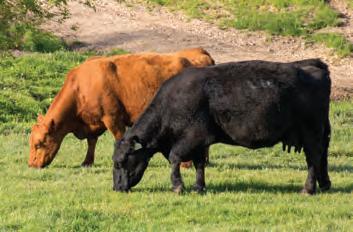
How does stocking rate affect weaning weights and pregnancy rates?
Stocking rates impact both the quantity and quality of forage available for grazing. Forage quality varies throughout the plant. As a general rule, quality
is highest in the top third of growth and lowest in the bottom third.
Falling dominoes
When forage quantity is reduced, cattle are not able to be as selective in what they graze and end up consuming a lower-quality diet. This leads to reduced milk production and cow body condition score. Less milk production leads to lower weaning weights. Weaning weights are also inhibited because calves are consuming lower-quality forage. Cow body condition score is the main factor impacting pregnancy rates most of the time.
had 25 cows. If expenses could be reduced by more than $5,350 per year, then the net return would be greater by only running 25 cows compared with 33 cows. In addition, running fewer cows would also reduce risk during times of drought or higher input costs.
Opportunities for savings
With fewer cows, less hay would need to be fed. Supplementation would also be reduced by running fewer cows because cows could select a higher-quality diet and stay in better body condition. Fewer cows may also mean lower spraying costs (reduced frequency and amount) because the additional forage would help shade out a lot of weeds.
The following example illustrates how fewer cows may generate more net income for an operation. Consider a property with 100 grazeable acres that, under the best conditions, may be stocked with 33 cow-calf pairs (three acres per pair) compared to that same property stocked with 25 pairs (four acres per pair) or even 20 pairs (five acres per pair). Assuming a weaned calf crop of 78% to 80%, an estimated gross income per year can be calculated for each situation. Calf prices have been adjusted slightly to account for higher weaning weights as stocking rates are decreased.
• 33 cows x 78.8% = 26 calves x $975 per calf = $25,350
• 25 cows x 80% = 20 calves x $1,000 per calf = $20,000
• 20 cows x 80% = 16 calves x $1,025 per calf = $16,400
Without considering expenses, it looks like stocking the property with 33 cows is the way to go, as it creates the most gross income. However, the question that must be asked is how much can expenses (for example, fertilizer, feed, spraying, and so forth) be reduced if the operation only
For the example above, reducing costs by $5,350 only means lowering costs by $53.50 per acre. Assuming a cost of 82 cents per pound of nitrogen, just reducing nitrogen fertilizer by 70 pounds per acre would save $57.40 per acre. This reduction would be both realistic and appropriate in this situation, and a larger reduction in nitrogen fertilizer would be possible in some cases. Reducing nitrogen fertilizer can be a good strategy, but cow numbers should be trimmed accordingly to prevent overgrazing. Additional savings from reduced hay and supplementation needs would result in even greater net income in this example.
For those producers whose primary goal is enjoyment, then just running 20 cows would be a great choice. It would minimize hay and supplementation feeding the most and provide the greatest risk management to prevent herd reductions during times of drought.
The strategies to generate the greatest net return will vary, but for many operations, reducing cow numbers can be a good approach, and it also helps reduce risk. •
18| Hay & Forage Grower | March 2023
BEEF FEEDBUNK
by Jason Banta
JASON BANTA
The author is a beef cattle specialist for Texas A&M AgriLife Extension based in Overton, Texas.
Are you ready?
MOST of the country is on the downhill side of what has been a pretty tough winter for the West, although the moisture was welcomed in many areas. It’s almost time to put the planters in the dirt and get the mowers ready to lay down that first cutting, which usually provides our highest yield of the year. We can’t always bank on summer rains these days, so the first cutting that comes from winter moisture is crucial.
Now is the time to go over your equipment from head to toe to make sure it is ready to go when the time comes. Most people have a plan for servicing their equipment themselves and others rely on help from their dealers. Some manufacturers even offer incentives to bring your machines to a local dealer for service. Take advantage of these dealer maintenance opportunities and have an experienced mechanic look over your machine with a fine-toothed comb. There are many dealers that offer parts discounts on the shop work they complete and for the parts you order to stock your farm’s shelves.
A 20-page checklist
One of the most extensive winter checks that we perform is on forage
harvesters and heads. This inspection can take a few days, depending on the chopper. Our tech goes over each machine with a 20-page checklist, looking for loose and worn parts along the way. The list is almost too involved for most farmers, but we encourage the chopper owners who want to help with the inspection to do so. This way, the operator can become more familiar with their cutter. This may not be a process that will work for everyone and every machine, but we have several customers who prefer to be there and help while the inspection is being completed. Dealers around the country offer different options when it comes to completing winter service. Most dealerships find that their mechanics are far more productive in their own shops rather than on the farm with the customer. So, some dealers have offered to split the payment or completely pay for the hauling of the machine to and from the dealership. The cost of shipping the unit can usually be a wash if you pay for a couple service calls to your farm to complete the work.
If you want to complete this off-season inspection yourself, I’ll give you a few guidelines to follow that can get you started in the right direction. On a pull-
type machine, baler, or mower, I suggest starting at the front with the hitch and drivelines. Inspect for any loose bolts and excess play in the yokes on the power takeoff (PTO). Go ahead and grease all the fittings to make sure they each accept grease. They are a lot easier to change in the shop than on a day when you are trying to get to the fields.
Working toward the rear of the machine, you should use a pry bar to check for any play or movement in bearings and ensure they are lubricated properly. Make sure hydraulic cylinders are holding pressure and not leaking internally.
Gears and chains
When you get to the main working components, cutterbar gears and chains on a baler require the closest inspection. There are some manufacturers that don’t require you to change the cutterbar oil in your mowers. I disagree with this recommendation. Would you drive your car for 50,000 miles without changing your oil? By draining the oil in your cutterbar, this offers a chance to inspect it for metal shavings and to examine it for any off-color, potentially allowing you to prevent a future problem.

Remove the chains on your baler and inspect them for play in the links. Once a chain is stretched too far, it doesn’t set properly and can start premature wear on the sprocket. It’s a lot easier to replace a chain or remove a link than it is to replace sprockets.
Spending some hours in the shop with your equipment in the off season will lead to more up time during harvest. Another benefit will be that you can troubleshoot the problems faster with your machines and have an educated conversation with your dealership’s mechanics to get you back up and running. Take advantage of maintenance incentive programs and parts savings. This is a good way to keep machine costs in check given the rising costs of production. •
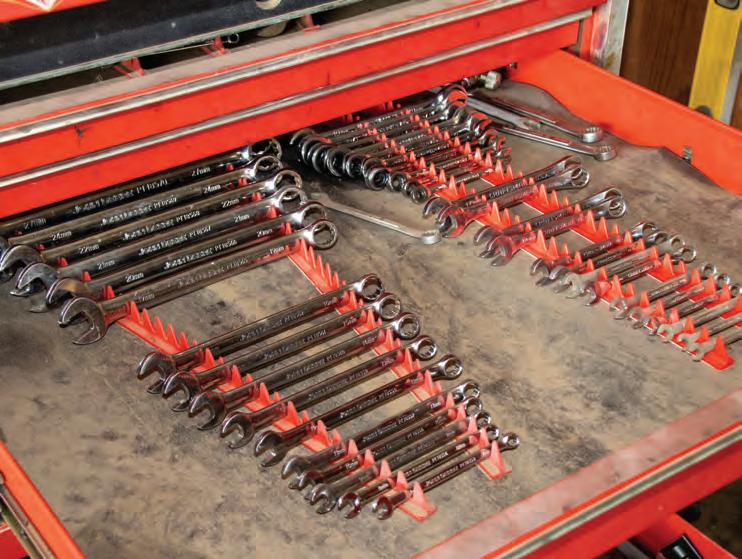 ADAM VERNER
ADAM VERNER
FORAGE GEARHEAD by Adam Verner March 2023 | hayandforage.com | 19
The author is a managing partner in Elite Ag LLC, Leesburg, Ga. He also is active in the family farm in Rutledge.
Mike Rankin
Cocktail forage mixes: WHAT DO DAIRY COWS THINK?
S DAIRY producers have been growing more corn silage and feeding it in lactating cow rations, there has also been a rise in the use of other annual forages. This has been driven by expanding interest in planting cereal grains after corn silage is chopped and harvesting forage the following spring.
The use of various annual forages are also becoming common after the cereal grain forage harvest. One popular option is to use annual forage mixtures that contain cool-season (Italian ryegrass) and/or warm-season (brown midrib sorghum-sudangrass) annual grasses and legumes such as clovers and hairy vetch. Often these are called “cocktail” forage mixes.
The grass type included in the mix is likely the most important consideration and depends on the soil conditions and manure management. Sorghum-sudangrass does not tolerate wet soils or can be damaged by in-season manure applications; however, Italian ryegrass will not tolerate dry soil conditions, so the two are sometimes mixed to provide some insurance for what Mother Nature may provide.
In our work with cocktail mixes in 2021 and 2022, we have focused on a mix with sorghum-sudangrass, Italian ryegrass, and legumes. As part of a project funded by the University of Wisconsin Dairy Innovation Hub, we evaluated on a field-scale the yield and quality of cocktail forage mixes on four farms, including the University of Wisconsin’s Marshfield Agricultural Research Station. Those results are in the March 2022 issue of Hay & Forage Grower
Forage quality differed
The project also included feeding the forage from the second harvest, as it contained a blend of the two grasses, while the first harvest was primarily sorghum-sudangrass and the third harvest was primarily ryegrass. We harvested the forage in mid-September with cutting and wilting for one day and then chopping for silage. The silage
was allowed to ferment for four weeks before feeding. Ideally, the silage would have been allowed to ferment longer as it was not yet stable and had aerobic stability issues (yeast growth) due to a slow feedout rate during the study.
The diets included a mixture of corn silage (29% of diet dry matter [DM]) and either an alfalfa-grass silage or the cocktail mix silage (18% of diet DM) in addition to concentrate ingredients (Table 1). The treatment rations were fed to 16 first-lactation cows that were on each diet for eight weeks. The cocktail mix silage was higher in fiber (51.6% neutral detergent fiber [NDFom]), but the fiber was much more digestible (68% NDFD30) compared to the alfalfa-grass silage (40.4% NDFom; 52.2% NDFD30). Soybean meal was used to help balance protein since the cocktail mix silage was lower in protein content.
Diet nutrients mainly differed in starch and fiber with the cocktail mix diet having less starch (26.8% starch) and more fiber (26.2% NDFom) than
the control diet (28.4% starch; 22.3% NDFom). The NDFD30 of the cocktail mix diet was higher (68% of NDF) than the control (61.9% of NDF), which helped make the diets more similar in energy. The cows on each diet ate similar amounts of feed (57.2 pounds of DM), with the cows fed the cocktail mix diet eating more NDF (14.9 pounds of NDF) than the control diet (12.8 pounds of NDF), so fiber level did not result in reduced intakes, which was likely due to the fiber levels being fairly low (22% to 26% NDF). As mentioned earlier, the cocktail mix silage had poor stability after opening due to a slow feedout rate, and the farm staff discarded spoiled silage to reduce the effects on intakes. Feed intakes for both treatment diets increased during the study, so the impact was likely minimal.
Milk and components offset
Looking at milk production, cows fed the control diet produced more milk (83.7 versus 81.4 pounds per
DAIRY FEEDBUNK by Matt Akins and Hidir Gumus 20 | Hay & Forage Grower |March 2023
Die t Forage Ingredient, % of DM Control Cocktail Corn silage Alfalfa/grass silage Cocktail mix silage Corn silage 29.229.2 Alfalfa/grass silage 18.3 Cocktail mix silage 18.3 Dry ground corn 19.3 17.5 Soybean meal 1.8 Protein mix 23.523.5 Liquid whey permeate 9.29.2 Mineral/urea 0.50.5 Nutrients, % of DM CP 16.8 17.0 6.43 18.5 12.9 NDFom 22.3 26.2 40.4 40.4 51.6 NDFD 30h, % of NDF 61.9 68.0 51.4 52.2 68.7 Starch 28.4 26.8 34.6 1.38 1.77 TDN 73.7 70.8 71.0 58.6 57.8 NEL, Mcal/kg DM 0.77 0.740.74 0.60 0.59
Table 1. Diet and forage nutrient composition
day). However, milk components were higher for cows fed the cocktail mix diet, with higher milk protein (3.45% versus 3.38% protein) and slightly higher milkfat (4.83% versus 4.74% fat). When considering both milk yield and components, the energy-corrected milk yields were similar between diets (89.2 pounds per day for the control and 88.2 pounds per day for the cocktail). The difference in components also resulted in similar fat and protein yields for cows fed either diet.
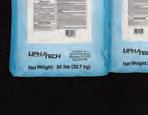
Total-tract digestibility of NDF was similar to in vitro estimates with the cocktail mix diet having 66.2% NDFD and the control diet having 63.8% NDFD. However, dry matter and starch digestibility were greater for the control diet (81.5% DM and 99.2% starch digestibilities) than the cocktail mix diet (78.7% DM and 98.7% starch digestibilities).
Interestingly, when we measured the greenhouse gas emissions from the
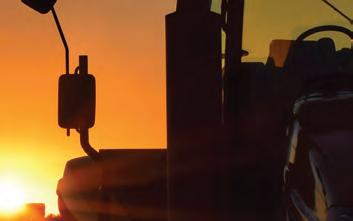


cows’ eructated gases, the cows fed the cocktail mix diet released about 9% less methane (411 grams of methane [g CH4] per day) than the control diet (450 g CH4 per day). The reason for the reduction in methane released is potentially due to lower overall diet digestibility; however, methane typically comes from fiber fermentation and the cocktail mix diet had higher fiber levels. This was an unexpected outcome, so the specific reason for differences in methane emission needs further investigation.
Account for variability







The take-home message from this study is that cocktail forage mixes can be used in lactating cow diets as a substitute for other hay-crop silages. Ration formulation should consider differences in protein, NDF, and NDF digestibility between the forages to maintain similar protein and energy

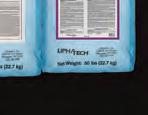
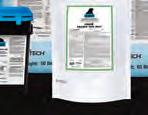
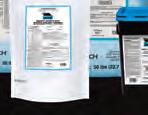
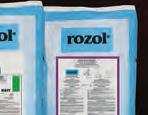
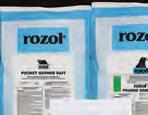
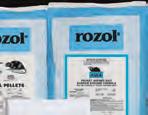
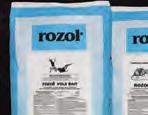
intakes. Based on this work, having a forage with higher fiber digestibility helped offset the difference in energy content due to higher fiber content and maintained similar milk component yields.
With the use of new or different forages, sampling for nutrient analysis and working with a nutritionist is crucial for proper balancing of diets. That’s because the nutrient contents will be different depending on the forage types, fertility, and especially between harvests of cocktail forage mixes. •

March 2023 | hayandforage.com | 21 FOR DECADES The headline says it all. With a long legacy of reliable & consistent performance, we are confident that Rozol will be YOUR rodent brand. New to Rozol? Start a legacy of your own and visit our website or contact a sales rep today. SOLVING YOUR RODENT PROBLEMS liphatech.com • 888-331-7900 PROTECTING YOUR LAND Always read and follow label instructions. Rozol Vole Bait, Rozol Pocket Gopher Bait Burrow Builder Formula, Rozol Prairie Dog Bait and Rozol Ground Squirrel Bait are Restricted Use Pesticides. LEARN MORE
MATT AKINS AND HIDIR GUMUS Akins (pictured) is a dairy scientist at the U.S. Dairy Forage Research Center in Marshfield, Wis. Gumus is a visiting scientist with the University of Wisconsin-Madison.

22 | Hay & Forage Grower | March 2023
by Amber Friedrichsen
WHEN the summer sun sets over northwest Illinois, the crew members of Silver Streak Ag Services LLC cut their engines and climb down from their tractor cabs. Their job might not be done — in fact, it may have just been getting started — but they submit to their growling stomachs and pause for a paper plate meal in the middle of the field. This is a nightly tradition for John and Monica Osterhaus, owners of the custom forage harvesting business near Chadwick, Ill.
Silver Streak Ag Services’ customer base spans from the Mississippi River to the outskirts of Aurora, and from the Wisconsin border to a half an hour south of Interstate 80. While their current radius paints a broad stripe across the top of the Prairie State, it started out as a dot on the map.
John grew up on a farm in southwest Wisconsin and entered the workforce as a mechanic. He and Monica moved west when he pursued a job in the oil and gas industry and later relocated their family of five to Chadwick when John got a job on a pipeline. As they settled into their new life, the Osterhaus’ children attended a new school, made new friends, and got new jobs on a local dairy farm. Then one day, the farm’s owner asked for John’s help as well.
“He approached me and said, ‘You need to buy a round baler so you can bale my hay,’” John recalled. “I thought about it, talked to a few other people nearby, and realized there was a need for more custom work. We officially started Silver Streak Ag Services in 2011, bought our first tractor and round baler, and I started baling hay part time.”
After a couple of years, business was on a steady ascent. John sold the round baler and purchased a large square baler to meet customer demands, and he started receiving requests for custom chopping, too. He and Monica created a three-year plan to expand, but they didn’t want to move too fast. That is, until an irresistible opportunity fell into their laps.
“In the winter of 2014, our biggest competition sold out. We decided this was our chance, and our three-year plan became a three-week plan. We bought a chopper, rented silage wagons, and hired out all of our hauling,” said the self-made businessman. “The next summer, we chopped about 700 acres of rye, hay, corn for silage, and corn earlage for eight or nine customers, and we thought we were really
busy,” he laughed.
Today, Silver Streak Ag Services has nearly 50 clients. John chops approximately 5,000 acres and makes up to 6,000 large square bales each year with the help of three full-time employees: Tim Schwank, Coby Snider, and Cody VanDyke. While they manage operations by day, Monica organizes harvest schedules, runs the business’ social media, and delivers dinner to their crew and their customers every night.
Small-scale service
Many of John’s clients are grain farmers who also raise beef cattle. The region’s rolling topography prevents them from growing row crops in some areas, so they plant forages and seed cover crops on hillsides and slopes to harvest for livestock feed.
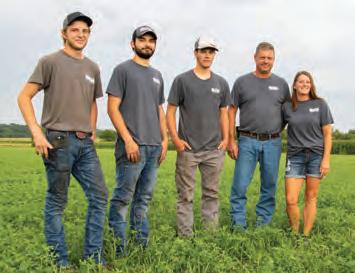
“The majority of our clientele are beef finishers or cow-calf producers,” John said. “A lot of the beef finishers want silage in their rations, but the cow-calf guys are our bread and butter. We chop more haylage and corn silage for cowcalf producers than anybody else in a given year.”
Of the total acres John chops annually, about 1,000 are alfalfa haylage. Another 1,250 acres account for small grains like wheat, barley, and triticale, and the remaining acreage is an almost even split between corn silage and earlage. Despite these numbers, though, each job is relatively small.
“Most of our chopping jobs are only 25to 50-acre fields, but we do a lot of them,” John explained. “It’s not uncommon for us to be at three or four customers in one day. We start out at one place, chop 25 acres, move down the road and chop another 50 acres, and so on.”
Because of this, communicating with clients is key to efficiency — especially when it comes to corn silage season. Some customers notify John when their corn is ready chop, whereas others trust him to scout their fields himself. One con-
versation about harvest sparks a chain reaction of calls.
“It’s not uncommon for me to be on 40 to 50 phone calls a day during corn silage season, talking to clients about the maturity of their corn, determining when they are ready to chop, and figuring out our route,” John said. “We try not to jump all over the place. If I have one customer who calls saying they are ready to chop, I make three more phone calls to his neighbors to see if they are ready, too.”
For full-service haylage jobs, the team runs a Pottinger triple mower, an Oxbo merger, and a Claas Jaguar 960. John owns several pull-type carts, and he regularly recruits some of his clients to haul silage. He also hires some of his customers who have pack tractors to help fill bunkers.
“We have a laundry list of people we can contact, and if we are in a bind, I know I can call them to see if they can help,” he said. “Some of them might help one day a year, and some will help us for three weeks straight, but if we didn’t have them, we wouldn’t be able to do this.”
John hires someone to bag silage, too, but he doesn’t have to rifle through his rolodex to find a farmer for this job. In addition to working for Silver Streak Ag Services, VanDyke manages his own bagging business. Not only does he bag silage for all of John’s customers, but he does custom work for other farmers as well.
Big on baleage
Silver Streak Ag Services also offers full-service baling. Soon after
continued on following page >>>
March 2023 | hayandforage.com | 23
Mike Rankin
Amber Friedrichsen
The team at Silver Streak Ag Services harvests alfalfa and corn silage for nearly 50 clients. From left to right are Cody Van Dyke, Coby Snider, Tim Schwank, and John and Monica Osterhaus.
investing in a large square baler, John purchased an individual bale wrapper. Several of his clients prefer baleage in their rations, and since he is one of the only custom harvesters who bales large square bales in the area, he decided to be one of the few to wrap them, too.
John wraps about 5,000 of the 6,000 bales he makes a year. He bales hay with a Hesston 4733 large square baler when forage is 35% to 45% moisture, but some producers ask for a drier product that is approximately 25% moisture, also known as “sweet hay.” Nonetheless, he enjoys making baleage more than dry hay because it offers more flexibility in production.
“When we make baleage, I can schedule when I’m going to bale a day in advance,” he said. “We mow one day, and we bale the next. I love being able to work that way because I have a better idea of how my week is going to turn out.”
Another factor of flexibility is that his clients with beef cattle aren’t necessarily concerned with forage quality; however, John also bales hay for a few dairy farms where this is a greater priority. In fact, one of his clients owns a goat dairy, and making baleage for these animals requires much more attention to detail.
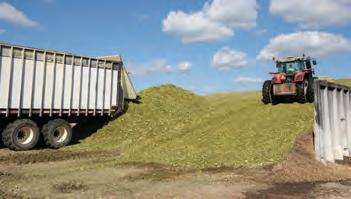
“On the goat dairy, we are shooting for what we call rocket fuel,” John asserted. “Goats have to have hay on
the drier side because they have such small stomachs, and they thrive on baleage that has a relative feed value of 180 or more. We have done as many as seven cuttings a year here because it’s hard to achieve that level of quality unless you’re really pushing it.”
Busy with repair
Really pushing it translates to a lot of wear on harvest equipment. This is especially true of the chopper, but instead of following a set trade schedule, John replaces his machines when they reach a certain number of working hours. Rather than buy new, though, he purchases used choppers with minimal depreciation.
“We look for used, low-hour, reliable equipment,” John said. “I would rather have something that is 10 years old with fewer hours but still does a good job, than a 2-year-old machine with a lot of hours that is constantly breaking down.”
With that said, some breakdowns are inevitable, so John carries extra fuel filters and spare belts with him everywhere he goes. As a mechanic by trade, he does most machinery maintenance himself, but Schwank, Snider, and VanDyke also have backgrounds in mechanics and welding, and their expertise is essential in the shop as well.
When he isn’t fixing his own fleet, John deals machinery for Meyer Man-
ufacturing and Meyer’s Equipment Manufacturing. The former corporation produces box trucks, semitrailers, and bunk feeders, whereas the latter designs and develops manure spreaders. He and his team also fabricate box trucks and bale squeezes, and they take on various repair jobs for other farmers.
Giving thanks
Even though John spends a lot of time behind the wheel — and under the hood — he and Monica believe their clients are the ones steering the business. Instead of implementing their own ideas, they established Silver Streak Ag Services to be an adaptable enterprise and have scaled their level of service by making changes to meet customer expectations.
To express their gratitude for their growth, the Osterhauses host a customer appreciation event every winter. John goes from controlling the chopper to manning the meat smoker, Monica prepares a smorgasbord of side dishes, and the couple welcome all of their customers to their home. They touch base with clients about the previous harvest and make plans for the upcoming season. More importantly, this annual gathering is an opportunity to strengthen the Silver Streak Ag Services community.
“It’s our way of thanking our clients,” Monica smiled. “We want them to know we don’t take them for granted. We don’t have a single customer who is not a good customer, and we feel very fortunate for that.” •
The author served as the 2021 and 2022 Hay and Forage Grower summer editorial intern. She currently attends Iowa State University where she is majoring in agricultural communications and agronomy.
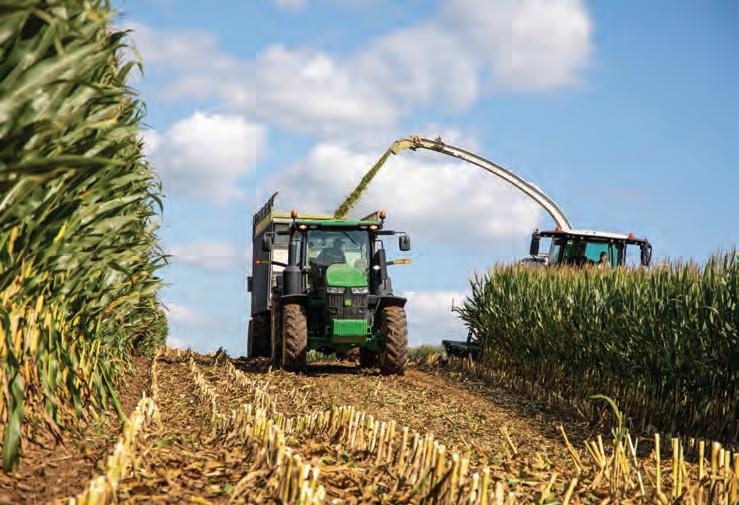

24 | Hay & Forage Grower | March 2023
John Osterhaus chops corn last fall for one of his many beef clients. “Most of our chopping jobs are only 25- to 50-acre fields, but we do a lot of them,” he explained.
Corn silage is delivered to a client’s bunker silo. Osterhaus has a ready list of people he can call on to help with packing.
AMBER FRIEDRICHSEN
Mike Rankin
Mike Rankin
The next frontier: protein and starch digestion
FORAGE nutrient digestion and energy yield is a function of the feed’s nutrient content and subsequent digestion by the animal. Fiber content and digestion has been a major focus in ruminant nutrition, laboratory measures, and forage quality for decades. Fiber quality is important and has been discussed in recent Feed Analysis interpretation columns. However, dairy and beef nutrition programs will be expanding focus over next decade to include a couple different nutritional analysis metrics in feed evaluation — protein and starch digestibility.
Protein and starch are highly valuable nutrients within forages. The protein contributed by high-quality grass or legumes provides an offset for expensive purchased feeds like soybean meal or canola meal. The protein digestibility is generally high for lush forages, though, in some cases, heat damage through inefficient fermentation or poor hay curing robs the animal from capturing the protein.
Intestinal digestibility analyses can help nutritionists account for lost protein. Several different laboratory measures capture and express protein intestinal digestibility in two different ways: protein digested in the intestine after bypassing the rumen (% of rumen undegraded protein) and the percentage of total feed protein that is undigestible in the intestines. The latter is a fairly straightforward way to understand the damaged protein in feed. The goal is less than 10% undigestible crude protein, meaning that 90% or more of the protein is used by the animal. Consult with your nutritionists for more insight here.
Corn and sorghum differ
Starch is a bit more like fiber and focuses on the rumen. Starch-rich feeds such as corn silage or sorghum silage contribute substantial pounds of starch to dairy and beef diets. Starch in these two forages is valuable and can offset purchased corn grain when the feed’s starch is highly digestible.
However, nutritionists treat corn and sorghum silage starch very differently due to differing starch digestibility between the two. For example, nutritionists may discount the total starch amount in sorghum silage because sorghum berries are less digestible than corn kernels.
There is potentially valuable starch in sorghum berries much like corn kernels, but sometimes cattle are less able to access the starch in berries due to the hard grain. That’s not to say that sorghum silage isn’t a valuable alternative forage. Sorghum silage will outperform corn in energy yield under extreme drought conditions. This is an unfortunate reality for many; hence, there will likely be more sorghum in dairy and beef diets in the future, and starch digestibility needs to be accounted for. Thankfully, today’s feed analysis report accounts for rumen starch digestibility.
In the rumen
Beyond sorghum silage, we are increasingly focusing on rumen starch digestibility to separate high-quality feeds from poor ones. Starch digested in the rumen yields energy for gain and milk production and provides energy and substrate to grow valuable microbial protein. The new crop slump associated with corn silage is mostly due to limited starch digestibility.
Fermentation enhances starch digestibility, which impacts how well the silage feeds. Over the past 10 years, feed-testing laboratories have brought feed rumen starch digestibility measures onto feed analysis reports, and we can accurately account for these factors.
As with fiber, laboratories measure rumen starch digestibility at different rumen incubation time points and express starch digestibility as a percent of total starch. These measures help rank feeds and tighten up diet formulation. With corn silage, the 7-hour starch digestibility goal is greater than 85% to 90%. The range in rumen starch digestibility is as low as
40% to 50% of total starch and as high as 95% for extremely well-processed and fermented silages.
It’s a balancing act
Within diet formulation software, rumen starch digestibility measures are combined with total feed starch to calculate digestible starch. Nutritionists now formulate for both total dietary starch and digestible starch. The latter stands to be more predictive for milk production potential or milk fat depression. Too little digestible starch hampers performance, but slightly too much rumen digestible starch can be costly in milkfat depression in dairy cows.
For dairy and beef cattle, starch is digested both in the rumen and lower digestive tract. Combine the two and we end up with total tract starch digestibility (TTSD). TTSD is accurately predicted with a manure starch analysis. The starch content in manure is known to negatively correlate to TTSD for dairy and beef cattle and even growing calves. The goal for TTSD in dairy and beef cattle is greater than 98% of total starch, understanding that the best farms can achieve these levels. There is little tolerance for valuable corn grain passing through in the manure.
Whether analyzing protein rich forage, starch-filled silage, or manure, the protein and starch digestibility metrics reported on nutrition analyses are worth considering when evaluating feeds or formulating diets. Using these protein and starch digestibility metrics can help your farm optimize your feeds’ potential and limit costly protein or energy supplements. •
JOHN GOESER
The author is the director of nutrition research and innovation with Rock River Lab Inc, and adjunct assistant professor, University of Wisconsin-Madison’s Dairy Science Department.

FEED ANALYSIS by John Goeser
March 2023 | hayandforage.com | 25
MULTISPECIES GRAZING HELPS PASTURES AND COWS
by Hugh Aljoe and Kevin Lynch
IT MIGHT not appeal or even occur to cattle producers to bring sheep or goats into their grazing operation, but multispecies grazing can benefit the forage, the ecosystem, the cattle, and the bottom line. This is especially true when transitioning to regenerative grazing.
In this article, we’ll answer several frequently asked questions by producers who have previously only run cattle, with Hugh Aljoe speaking about experiences on Noble Ranches and Kevin Lynch sharing what he’s learned during 35 years of raising small ruminants along with cattle and bison.
Why should a cattle producer consider adding small ruminants to their grazing operation?
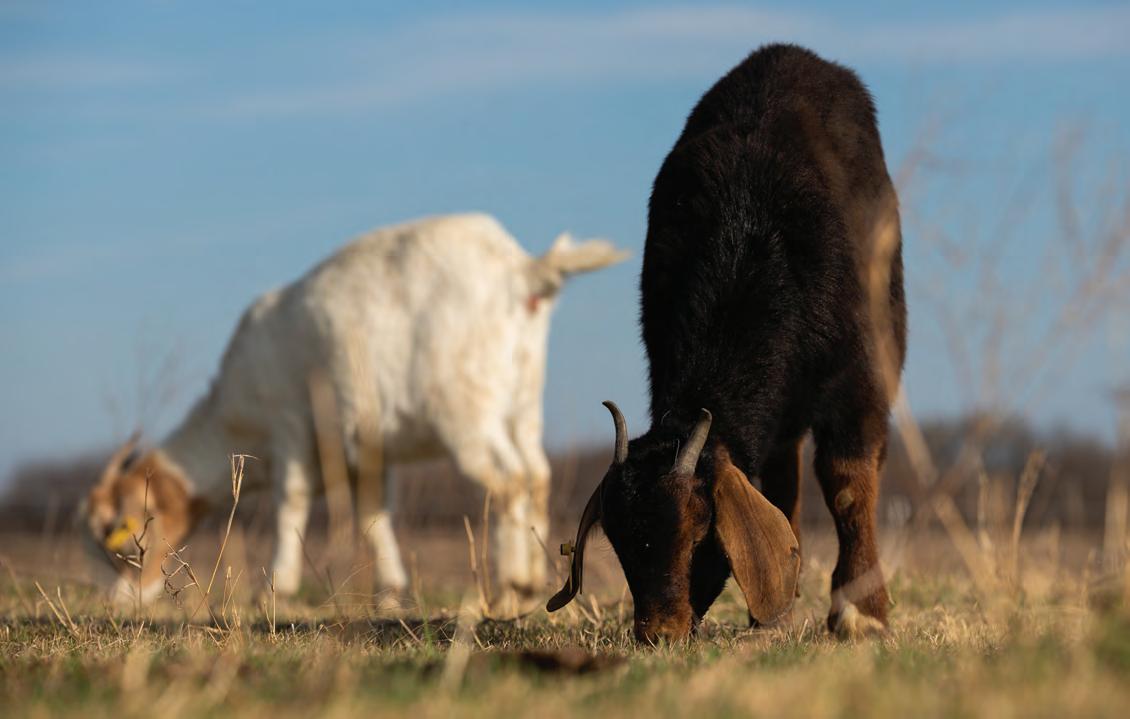
Aljoe: When transitioning to regen-
erative grazing and cutting back on chemical inputs, it’s critical to diversify your livestock. You can utilize much more of your rangeland with sheep and goats than with cattle alone, and the small ruminants control, to a large extent, weed and brush problems and fertilize the soil differently than the cattle do. By grazing multiple species and managing your grazing, you’ll have more plant species being utilized as forages, a different dynamic, and the ecosystem will respond with desirable grass species emerging, which benefits the cattle.
Lynch: You can even benefit from adding sheep on a monoculture of bermudagrass because they graze the grass differently than cattle. Plus, if you stop spraying herbicides, you’ll have all the forbs you want for the sheep while they’re taking care of your weeds. Goats like to browse, so they help keep woody species from encroaching on grasslands.
If you have a lot of brush and you start grazing goats, you’ll see a difference in only about 60 days.
When it comes to fertilization, what’s different about sheep and goats versus cattle and/or commercial fertilizer?
Aljoe: The forbs and woody plants that the small ruminants graze aren’t typically plants that get cycled through the cattle. Many times, the forbs, in particular, are rich in some of the nutrients, especially micronutrients, that you don’t observe in grasses. Plus, we’ve noticed that the pellet distribution is more uniform and broader than you have with cow piles. The pellets break down a lot quicker than cow manure, and the nutrients they provide are more readily available than inorganic forms. So, these natural soil amendments are giving you different nutrients, ones
26 | Hay & Forage Grower | March 2023
All photos Noble Research Institute
Livestock diversification becomes important when trying to cut back on chemical inputs.
that are normally in low quantities at the soil surface.
Will sheep and goats compete for grass forage, causing you to change cattle stocking rates?
Aljoe: You can run one sheep or goat (depending on the plant types in your landscape) per every animal unit of cattle that you’re running and never have a substitution effect on your stocking rate. So, they’re like free animal units you get to graze. With us looking to change our ranch ecosystems back to true savanna grassland with intermittent trees, we may even run two sheep or goats for every cow to get the ecosystem results we need.
Lynch: With goats grazing and browsing woody species, you could go even higher than one-to-one because most times the cows are not grazing those areas preferred by the small ruminants. Plus, sheep and goats usually aren’t grazing the same species as the cattle. They will start eating grass sometimes, but they have a variety of eating habits and change what they graze or browse every day. Sheep and goats use their prehensile lips to pick and choose, taking just a leaf or two off a luscious forb or woody plant and going on to the next one. They might take a bit of tender grass when it first comes up. They are very selective of the plants parts they eat and seem to choose a great variety of plants throughout each grazing event.
What type of sheep and goats are best suited for multispecies grazing?
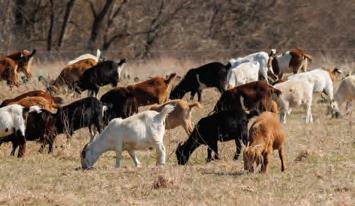
Lynch: Hair sheep have a lot of advantages over wool sheep for grazing — they’re hardy and low-maintenance; you don’t have to provide sheds or cover for them; you can keep them in with a single hot wire (versus permanent fencing for wool sheep); and it takes only five months to have a lamb that you can then market about 90 days after birth at 50 to 60 pounds.
Here in Oklahoma, I think the best four breeds are Katahdin, Dorper, Royal White, and St. Croix. For goats, I like to go with Spanish, Kiko, Savanna, and TexMaster. We use Dorper hair sheep and Spanish and Kiko goats on the Noble Ranches because they’re parasite resistant and low maintenance. And, amazingly, the Spanish goats can browse brush up to 7 feet above the ground.
What is different about running small ruminants on a ranch? What do you have to add for infrastructure?
Several key things are different and will need to be accommodated:
Guardian dogs (or a jenny donkey or llama) are needed to protect small ruminants from predators such as coyotes and bobcats. With an open landscape, one guardian dog is needed for each 100 ewes or nannies; for hilly land with woods, use one dog for every 50. The dogs will need food on-site, preferably in a portable feeder that can be moved as you rotate grazing paddocks. Separate water troughs. Sheep and goats don’t prefer to drink from a large tank or pond because they don’t like their feet to get muddy, but they drink only about 1.5 gallons per day, so a small portable water system works best.
Working facilities will require retrofitting for sheep and goats. It is not necessary to purchase or build a separate facility for small ruminants. Typically, a cattle-working facility can be easily retrofitted to accommodate sheep and goats by adding net wire or livestock panels (with close-spaced wires) around the perimeter and along crowding areas.
How would you recommend starting out with smallruminant grazing?
Lynch: I would start with one species — sheep or goats, buying either bred ewes or bred nannies so that you have income from the offspring right away. Buy them from someone who has been running electric fencing, so they are already trained to respect a hot wire. As you would expect, the sheep are easier to manage than the goats.
Overall, what are the biggest benefits from multispecies grazing?
• You get to add an enterprise that will pay for itself in two or three years, and one that’s not difficult to manage, if you’re already doing a good job with your cattle and grazing programs.
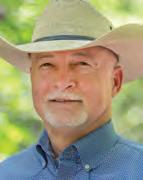
Electric fencing needs to be set up specific to the species. Hair sheep can be kept in with one hot wire, but it needs to be at nose-height (about 14 to 16 inches) when the ewes are walking, which is lower than a single wire would be for grazing cattle. Goats need three hot wires to keep them in. It can be polywire, which is easiest for temporary fencing when rotating grazing paddocks. Keeping sheep and goats happy with plenty of their favorite forage to graze is the best way to keep them from roaming.
Graze sheep/goats separately from the cattle. When starting out, cattle, especially mature cows that have not been raised with guardian dogs and small ruminants previously, will not appreciate what the guardian dogs are trying to do. At Noble, with our adaptive grazing, much of the year we let the cattle graze an area first, and then the sheep and goats come in behind and pick out what they want. In the spring, we try to leave the sheep or goats in for only a few days so they don’t switch from forbs to the new grass and set it back.
• The small ruminants are grazers that complement and do not detract from your main cattle enterprise.
• Sheep and goats provide cycling of additional soil nutrients, which are better allocated across the landscape.
• You’re turning the problems of weeds and brush encroachment into a financial asset — they become a natural resource used to make money.
• You have the opportunity to get closer to the original ecosystem on the prairies when elk, mule deer, and antelope grazed alongside the bison. They likely used different forages and contributed nutrients in a variety of ways, fostering lush native forages and healthy soils. •
March 2023 | hayandforage.com | 27
One sheep or goat can be added for every animal unit of cattle without reducing stocking rates.
HUGH ALJOE AND KEVIN LYNCH
Hugh Aljoe is the director of producer relations and Kevin Lynch is a research associate in the research services group, both at Noble Research Institute in Ardmore, Okla.
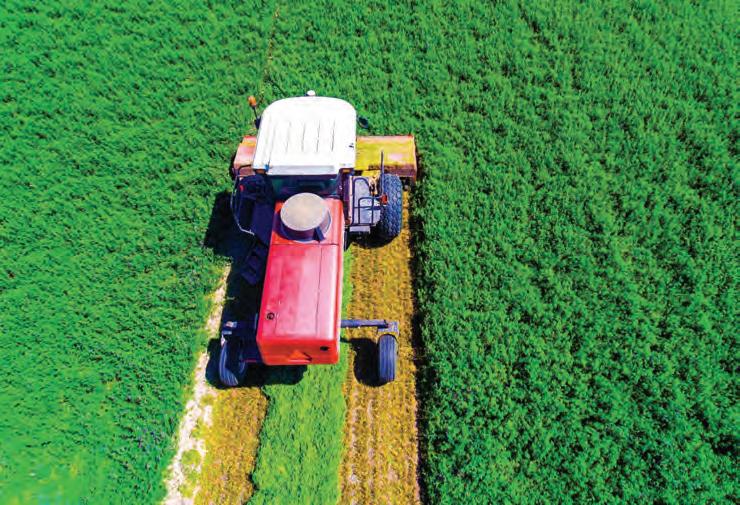










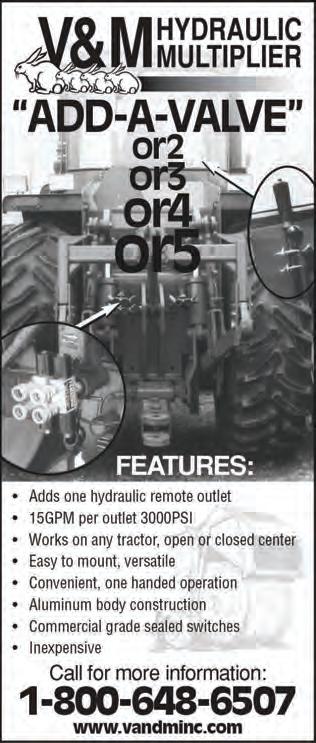
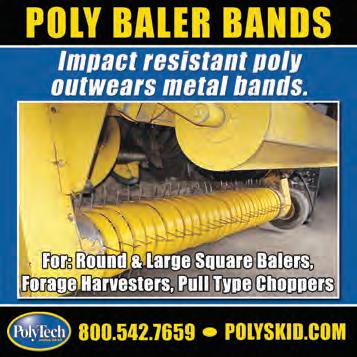
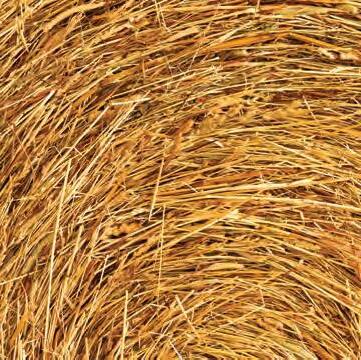
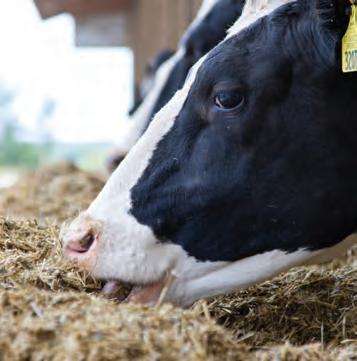



BUYERS MART 28 | Hay & Forage Grower | March 2023 www.prettygoodtwine.com (800) 552-3295 Net Wrap Baler Twine Hay Tarps Silage Film Hay Preservative ARE YOU READY? Hay season will be here soon! S ILO- K I NG S ILO- K I NG® Forage & Grain Treatment TreaT Your HaY and Forages THe rigHT WaY BooknoW andsaveWiTH special discounTs No Surprises. www.sealprosilage.com 559-779-5961 Point 5 U.S. QUALITY ASSURANCE CERTIFIED ®Sealpro Our 3rd-party lab’s techs have never seen a cow. Or made film. We won’t take chances on your valuable commodities. Sealpro® tests for barrier, strength, and cling are run at a professional materials lab, not by the manufacturer. It’s Point 1 of our 5 Point Quality Assurance Promise. Oxygen Barrier Films and Covers Reliable. Consisent. Supported. 4th Edition Feeding Guide
hoards.com/bookstore
by Mike Hutjens
NEED HELP HANDLING LARGE ROUND BALES? WORKSAVER HAS THE ANSWER!

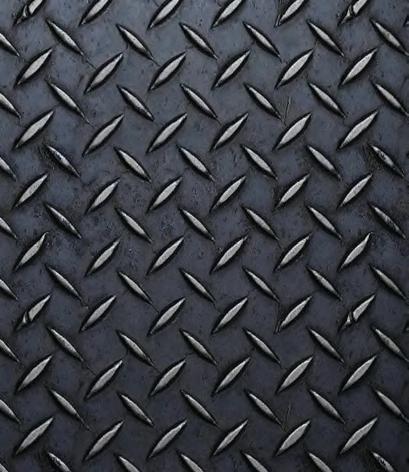

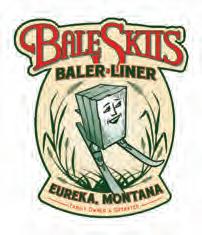



Worksaver’s DBH-6000 is the right attachment for transporting two round bales at once. Its rugged 76” wide square frame design with four bolt-in spears allows the transport of two 6-ft. round bales, reducing trips across the field. Compatible with Cat. II/III Quick Hitches for easy hook-up.


March 2023 | hayandforage.com | 29 BUYERS MART Worksaver, Inc. Litchfield, IL • Phone: 217.324.5973 DESIGNED. ENGINEERED. REMARKABLE VALUE. VISIT WORKSAVER.COM TO LEARN MORE
DBH-6000, 3-pt. Bale Spear
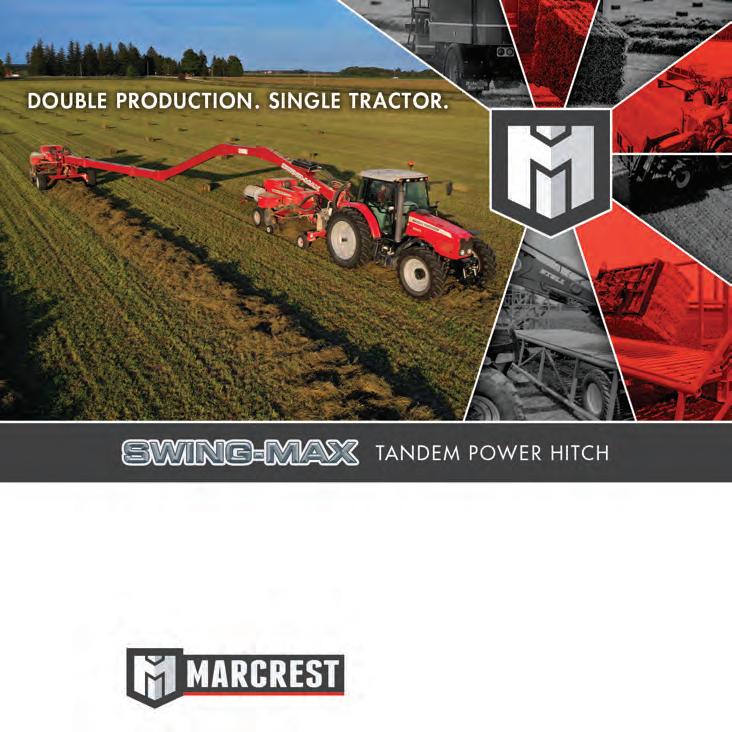

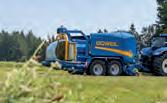






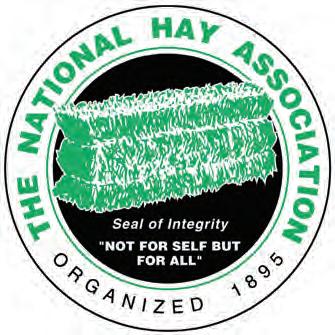
BUYERS MART 30 | Hay & Forage Grower | March 2023 The Round Bale Wrapper for any terrain // G5012 Trailed machine with bale pick-up & twin wrapping arm www.goeweil.com Philip Kieser sales@goeweil.com | (309) 750-5639 INTERESTED? Contact us NOW Reliable & Consistent. In any terrain. Join NHA today! www.nationalhay.org
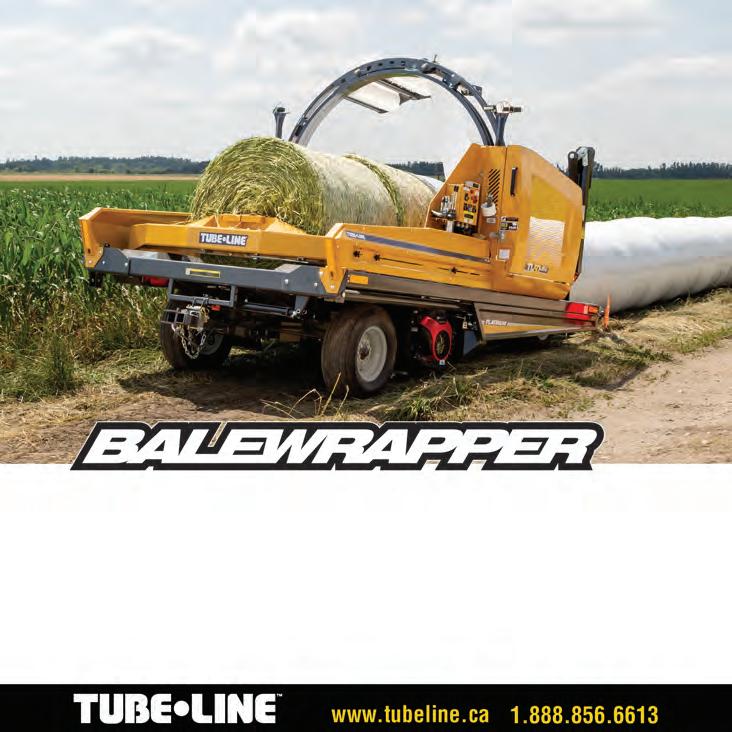



March 2023 | hayandforage.com | 31 BUYERS MART
to provide
high efficiency
proven reliability. To ensure that everyone can reap the benefits of the high moisture hay, Tube-Line BaleWrappers are available in multiple configurations to suit your needs and your budget. For more information please visit us online or contact your nearest dealer. eHay WEEKLY • Headline news and field reports • Market insight and crop updates • Original features • Event coverage • Direct to your inbox every Tuesday morning Electronic Newsletter Our e-newsletter is FREE to qualified subscribers! Sign-up is fast and easy at hayandforage.com
The new generation of TL Series inline bale wrappers from Tube-Line are built
producers and custom operators with
and
Corn

From Seed to Feed

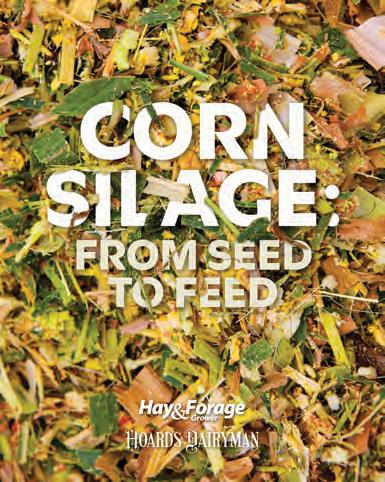


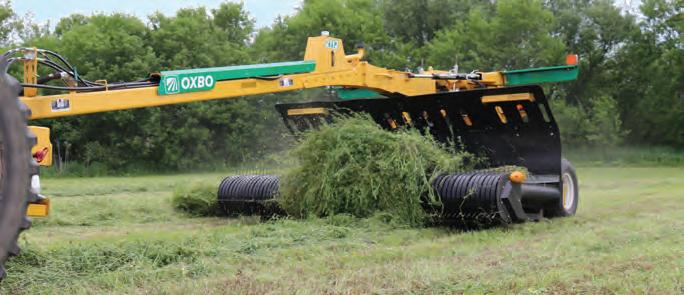
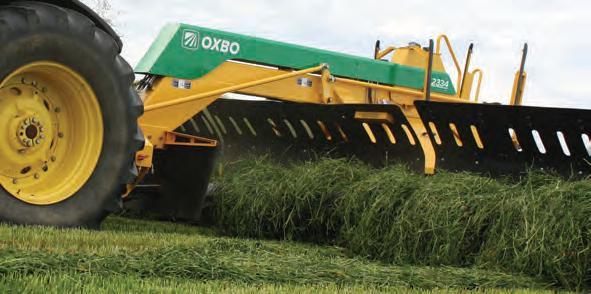
BUYERS MART 32 | Hay & Forage Grower | March 2023 No matter the size of your operation, there is an Oxbo designed to fit your needs. LEARN MORE AT OXBO.COM 2114 2340 2330 & 2334 WE LEAD. OTHERS FOLLOW. Accepting orders now. See your local dealer TODAY! 5 MODELS RANGING FROM 12 TO 40-FEET. An ideal book for dairy producers, farm consultants, and dairy or agronomy students! NEW RELEASE! Order Today! $24.95 plus S&H
Silage:
Every ration needs a strong foundation. This 80-page, perfect bound manual explains best practices and references for each stage of corn silage management. Five expert authors detail guidelines for: • Production • Harvest • Storage • Feeding Available at: www.hoards.com/silage or call 920-563-5551. Hoard’s Dairyman Books • Fort Atkinson, WI 53538 • 920-563-5551 • hdbooks@hoards.com
CLASSIFIED ADVERTISING
$2.50 per word per issue.10 word minimum. 920-563-5551 ext. 125
FARM EQUIPMENT
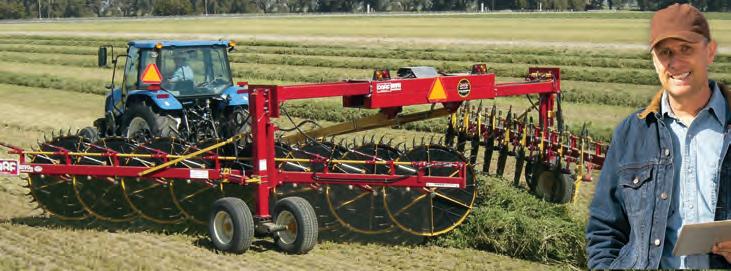
BALEWAGONS: New Holland self-propelled & pull-type models/ parts/tires/manuals. Can finance/ deliver. 208-880-2889, www. balewagon.com
JAWIBA/15
Advertise in the Buyer’s Mart Section


For more information contact:
Kim Zilverberg Kzilverberg@hayandforage.com
Jenna Zilverberg Jzilverberg@hayandforage.com
PARTS AND SERVICE SUPPORT
Made in the USA
97 YEARS of unmatched performance, proven longevity and customer service. Call today to learn more!
PRE-CONGRESS TOURS
Central Grasslands
Tour ranches, native prairie hay meadows, and other grassland-centered agricultural productions in Texas, and Oklahoma. Additional stops include the Cesar Kleberg Wildlife Center, the National Weather Service Station, and more iconic sites.


Subtropical
This tour focuses on operations and venues across Florida, Georgia, South Carolina, and North Carolina. Stops include a behind-the-scenes tour of Desert Farms, multiple agricultural research centers, and the 250-room, French Renaissance chateau Biltmore Estate.
Sub-Themes
Sub-Theme 1: Grassland Ecology
Sub-Theme 2: Grassland Production & Utilization
Sub-Theme 3: Livestock Production Systems
Northwest
International Grassland Congress
KENTUCKY,USA 2023
MAY 14-19, 2023
Visit one of the most productive agricultural regions in the world with diverse climates, rich soils, and large-scale irrigation systems. See forage productions, dairy operations, and the growing wine industries of Oregon.
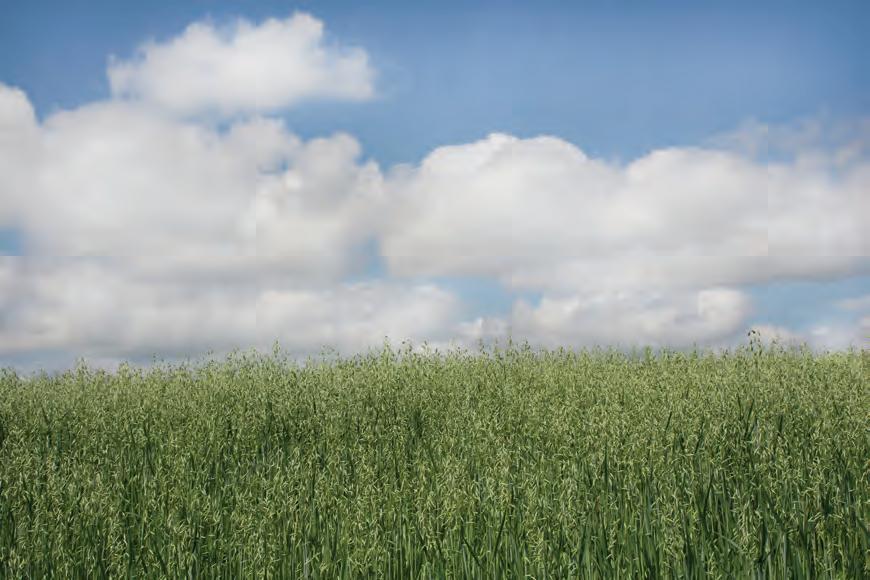
Northeast
Explore the most historic area of the United States. The tour begins in Philadelphia, PA, and then moves on to Delaware, Washington D.C., and Virginia. Along with historic sites, the tour will also stop at New Holland and Wye Angus.
Sub-Theme 4: Grassland Sustainability, Innovations & Initiatives
Sub-Theme 5: Grassland Policies, Social Issues & Policies, Social Issues & Ecosystem Services
For more information and registration scan the QR code with your mobile device or visit

INTERNATIONALGRASSLANDS.ORG
HOSTED BY:
March 2023| hayandforage.com | BUYERS MART
Northeast Pasture Consortium Annual Meeting
March 8, Virtual
Details: grazingguide.net/news/ winter23.html
Great Lakes Forage & Grazing Conference
March 9, St. Johns, Mich.
Details: bit.ly/HFG-GLFGC23
Novel Endophyte Renovation Workshops
March 21, North Petersburg, Va.
March 23, Mt. Vernon, Mo.
March 28, Tanner, Ala.
Details: grasslandrenewal.org/events
Central Plains Dairy Expo
March 28 to 30, Sioux Falls, S.D.

Details: centralplainsdairy.com
Tri-State Dairy Nutrition Conference
April 10 to 12, Fort Wayne, Ind.
Details: tristatedairy.org
Virginia Fence Building School
April 19, Bedford, Va., or April 26, Harrisonburg, Va.
Details: vaforages.org/events
International Grassland Congress
May 14 to 19, Covington, Ky.
Details: internationalgrasslands.org
Four-State Dairy Nutrition and Management Conference
June 7 and 8, Dubuque, Iowa
Details: fourstatedairy.org
Grassfed Exchange Conference
Beef herd shrinks, dairy grows
There are a lot of moving parts currently influencing hay markets. The nation’s cattle herds are moving in opposite directions with the beef cow herd as small as it’s been since the early 1960s; however, the dairy herd is growing.
Hay exports in 2022 ended as a
mixed bag, but mostly stagnant to down. The recent droughts in the Great Plains and western Corn Belt continue to buoy hay prices in those regions.
The prices below are primarily from USDA hay market reports as of the beginning of mid-February. Prices are FOB barn/stack unless otherwise noted.•
For weekly updated hay prices, go to “USDA Hay Prices” at hayandforage.com
Great resource book!
To Order: 920-563-5551 or www.hoards.com/silage
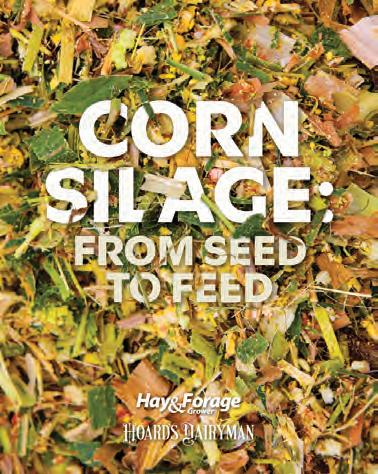
HAY MARKET UPDATE
FORAGE IQ 34 | Hay & Forage Grower | March 2023
Supreme-quality alfalfa Price $/ton Texas (west) 320-360(d) Colorado (southeast) 360Washington 270 Idaho (south central) 280-310Wisconsin (Lancaster) 150-170 Iowa 355 Wyoming (eastern) 270-285 Iowa (Rock Valley) 248-260 Fair-quality alfalfa Price $/ton Iowa (Rock Valley)-lrb 245-270California (southeast) 300 Kansas (north central) 285 Colorado (southeast) 240 (d) Kansas (southwest) 315-358Idaho (south central) 205-225 Minnesota (Sauk Centre) 230-300Iowa (Rock Valley)-lrb 153 Missouri 250-300Kansas (north central)-lrb 220-240 Nebraska (central) 290 Kansas (south central)-lrb 280-298(d) Oklahoma (northeast)-lrb 350 (d)Minnesota (Pipestone)-lrb 180-195 Oklahoma (northwest) 380(d)Minnesota (Sauk Centre) 150-195 Oregon (Lake County) 350 Missouri-lrb 125-150 South Dakota 250-275Montana 225 Texas (Panhandle) 400-420(d)Oklahoma (northwest) 250 Texas (west) 400-425Oregon (Lake County) 250 Premium-quality alfalfa Price $/ton Pennsylvania (southeast) 200 California (central SJV) 465(d)South Dakota (Corsica)-lrb 170-195 California (southeast) 305-320Washington 250 Colorado (northeast)-lrb 285 Wisconsin (Lancaster) 110-135 Iowa (Rock Valley) 210-218 Wyoming (western)-ssb 200 Kansas (northeast) 246 (d) Bermudagrass hay Price $/ton Kansas (south central) 325 Alabama-Premium lrb 150-200 Minnesota (Sauk Centre) 160-210California (southeast)-Premium ssb 350 Missouri 180-250Texas (central)-Premium ssb 350-400 Montana 250 Texas (southern)-Fair/Good lrb 120-130 Oklahoma (central) 275 Bromegrass hay Price $/ton Oklahoma (northwest)-lrb 325 (d)Kansas (northeast)-Good 175 Oregon (Klamath Basin)-ssb 360Kansas (southeast)-Premium 225 Oregon (Lake County)-ssb 380 Orchardgrass hay Price $/ton Pennsylvania (southeast) 280-350Oregon (Crook-Wasco)-Premium 400 South Dakota (Corsica)-lrb 230 Oregon (Crook-Wasco)-Good 300 Texas (Panhandle) 365-385(d)Pennsylvania (southeast)-Premium 250-280 Washington-ssb 405 Timothy hay Price $/ton Wisconsin (Lancaster) 200 Montana-Premium ssb 360 Wyoming (western)-ssb 285-350 Pennsylvania (southeast)-Good ssb 260-270 Good-quality alfalfa Price $/ton Washington-Good/Prem ssb 456 California (southeast) 250-340 Prairie/meadow grass hay Price $/ton Colorado (southeast) 260 Colorado (northwest)-Fair/Good 240 Idaho (southwest)-ssb 285 Nebraska (central)-Good lrb 210-225 Iowa-ssb 260 Pennsylvania (southeast)-Premium 230-280 Iowa (Rock Valley) 173-180 Oat hay Price $/ton Kansas (north central) 240 Iowa (Rock Valley)-Good/Prem lrb 193 Kansas (southwest) 250-275Kansas (southwest)-Fair/Good 170 Minnesota (Pipestone)-lrb 210-215 Oregon (Klamath)-Good 225 Minnesota (Sauk Centre) 160-230Wyoming (western)-ssb 200 Missouri-lrb 150-180 Wheat Straw Price $/ton Nebraska (eastern) 200 Idaho (south central) 110-115 Nebraska (western) 275-285 Iowa (Rock Valley) 130-175 Oklahoma (central) 300(d)Kansas 120 Oregon (Lake County) 315-330Minnesota (Sauk Centre) 100-120 Pennsylvania (southeast) 210-285 Pennsylvania (southeast) 115-170 South Dakota (Corsica)-lrb 205-220South Dakota (Corsica)-lrb 115 Abbreviations: d=delivered, lrb=large round bales, ssb=small square bales, o=organic
REDUCE

KUHN’s line of GMD trailed mowers offer wide working widths, simple adjustments and low maintenance for dependable grass and forage harvesting. They provide easy tractor hookup and exceptional cutterbar flotation and contour following. The trailed design also lowers the tractor ballast requirement, allowing use with smaller tractors, while maintaining excellent stability in both work and transport.
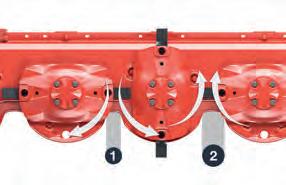


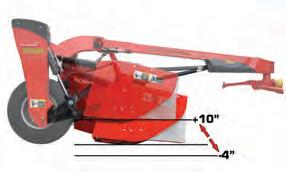

INVEST IN QUALITY ® www.kuhn.com
DOWNTIME. MAXIMIZE PRODUCTIVITY.
Visit our website to locate a Dealer near you! GMD 51 TL SERIES Trailed Disc Mowers 8’10” - 13’ cutting widths drawbar or 2-point hitch Optidisc ® cutterbar provides cleaner cut in difficult field conditions Gyrodine ® swivel hitch allows over 90° turns for outstanding maneuverability Pro-Active Lift ® system for quick adaptation to terrain changes Constant
Float ® suspension closely follows ground to reduce missed crop

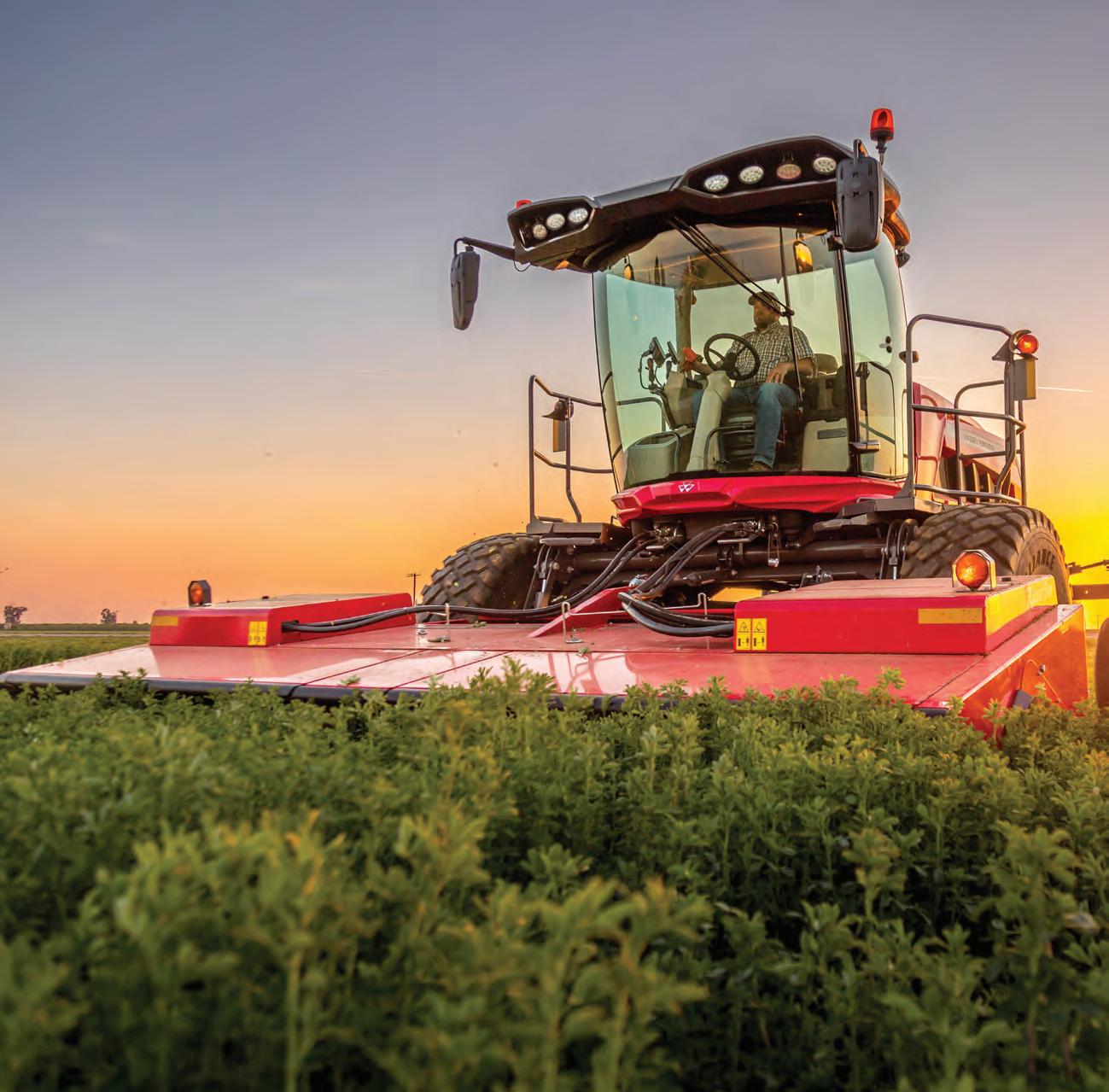
©2023 AGCO Corporation. Massey Ferguson is a worldwide brand of AGCO Corporation. Hesston is a brand of AGCO. AGCO, Massey Ferguson and Hesston are trademarks of AGCO. All rights reserved. | HS23N001FC Learn more at www.masseyferguson.us or visit your dealer today. ALL
CONDITIONS. ALL DAY LONG. The Hesston by Massey Ferguson® WR Series self-propelled windrower helps you produce high-quality hay faster, more efficiently and more comfortably. An AGCO Power™ engine and high-capacity hydraulics give you the torque and horsepower to cut through any condition from the comfort of our farmer-focused cab.
CROP
intakes. Based on this work, having a cial for proper balancing of diets. That’s different depending on the forage types,
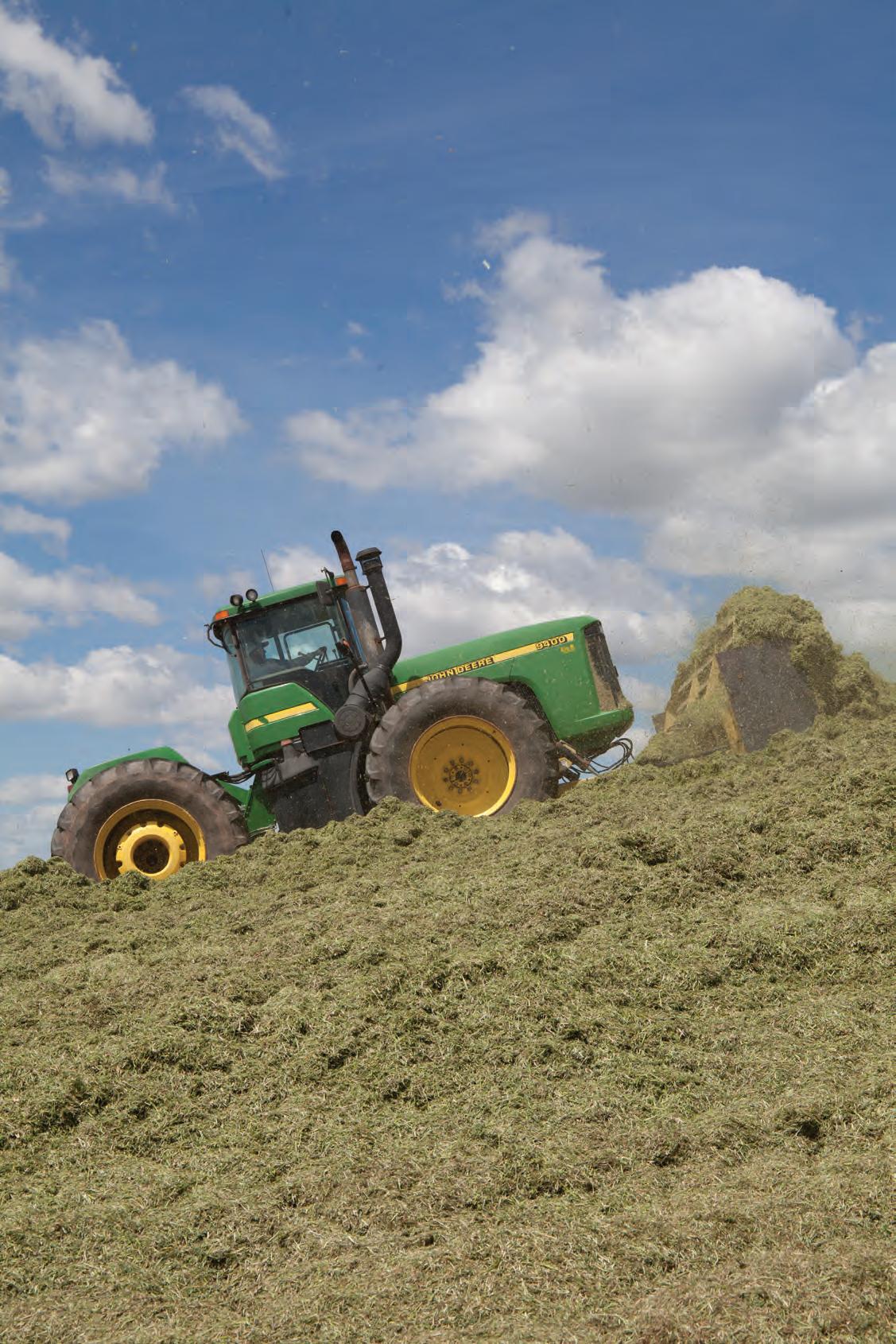
4 Safe practices
4 Educational Resources


21
silagesafety.org SEND EVERYONE HOME SAFE SAFETY FOUNDATION
MATT AKINS AND HIDIR GUMUS Akins (pictured) is a dairy scientist at the U.S. Dairy Forage Research Center in Marshfield, Wis. Gumus is a visiting scientist with the University of Wisconsin-Madison.
































































































































 by Nicolas DiLorenzo, Federico Podversich, and Federico Tarnonsky
by Nicolas DiLorenzo, Federico Podversich, and Federico Tarnonsky









 ADAM VERNER
ADAM VERNER


























































































